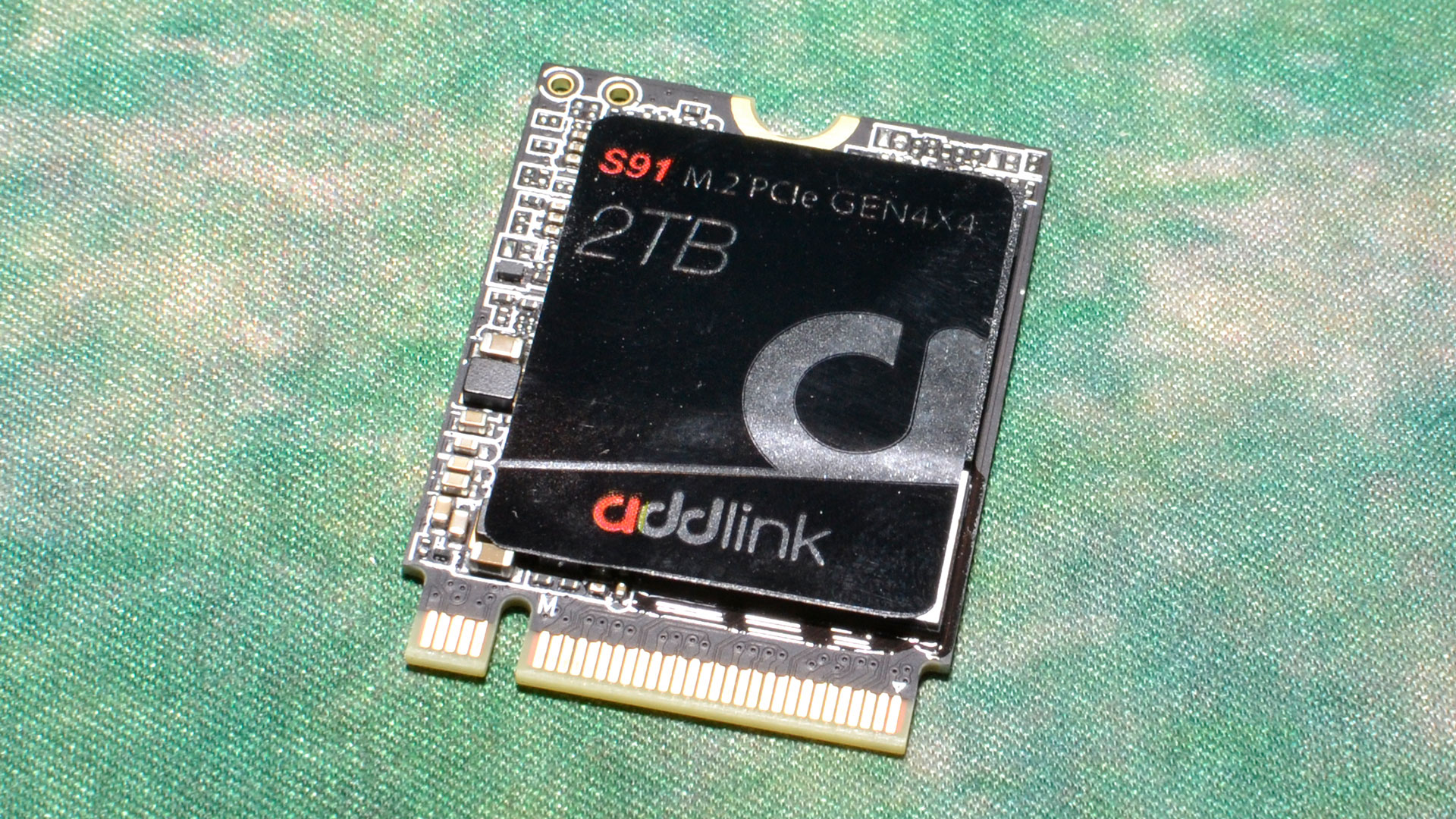Why you can trust Tom's Hardware
Comparison Products
The Addlink S91 faces off with other M.2 2230 SSDs that we have tested, including the Rocket 2230, the Corsair MP600 Mini, the older Inland TN436, the newer Inland TN446, and the similar Sabrent Rocket Q4 2230. This covers most current and relevant retail options, with the Team MP44S yet to come. The WD SN740, not shown, is essentially a WD Black SN770. The Micron 2400, also not shown, is similar to the Crucial P3 Plus but with an SMI controller. These two drives will be referred to more generally, where applicable, but are not explicitly reviewed as they are OEM devices.
Steam Deck - General
To gauge general Steam Deck performance, we engage in a variety of typical storage situations with active time measurement. These activities include dealing with the default SteamOS through initial setup, re-imaging, initial booting, and booting in general. For game testing, we see how long it takes to install and boot the popular title Hollow Knight. For a full explanation of our testing procedure, see our Steam Deck storage testing article.
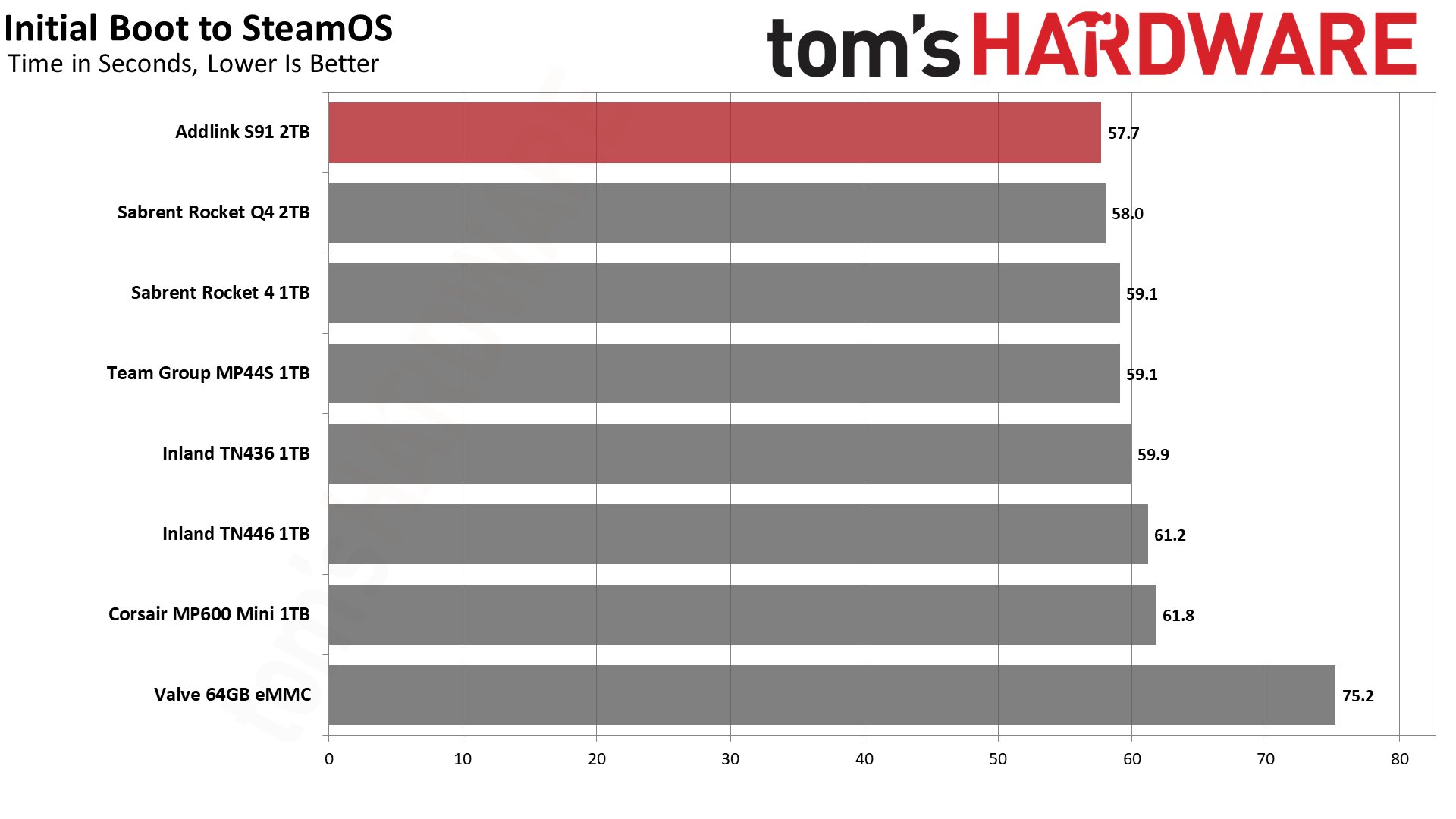
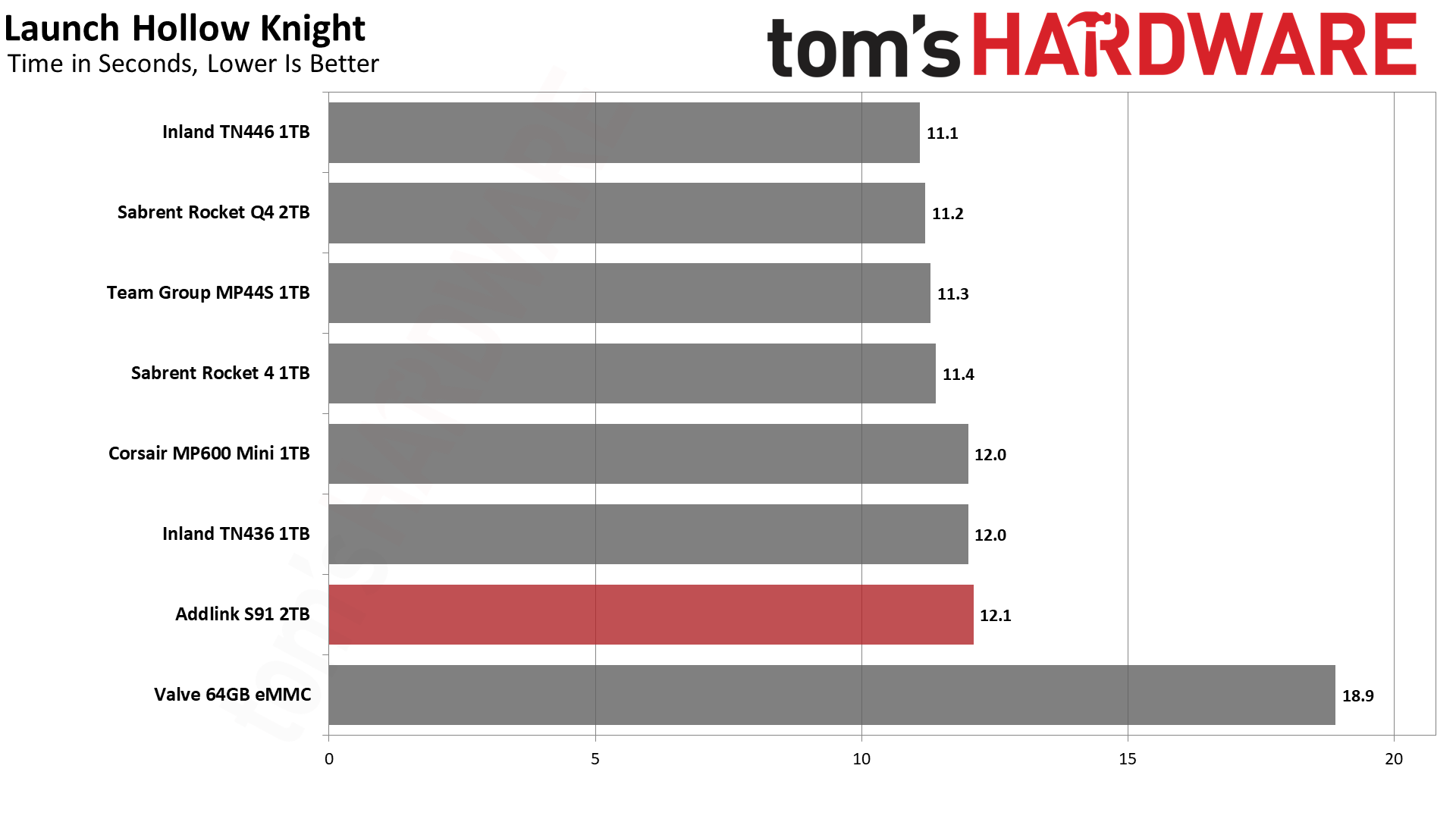
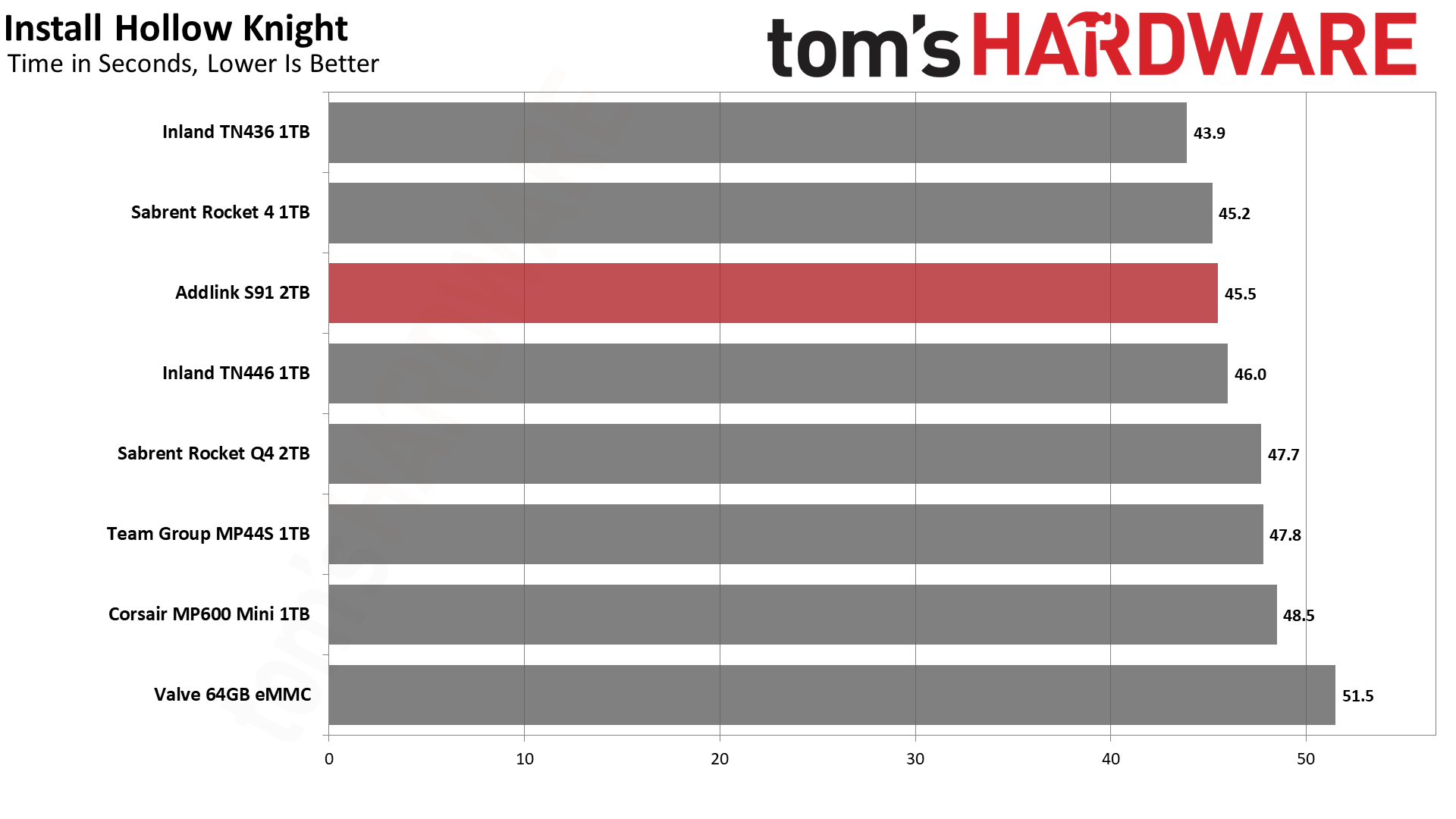
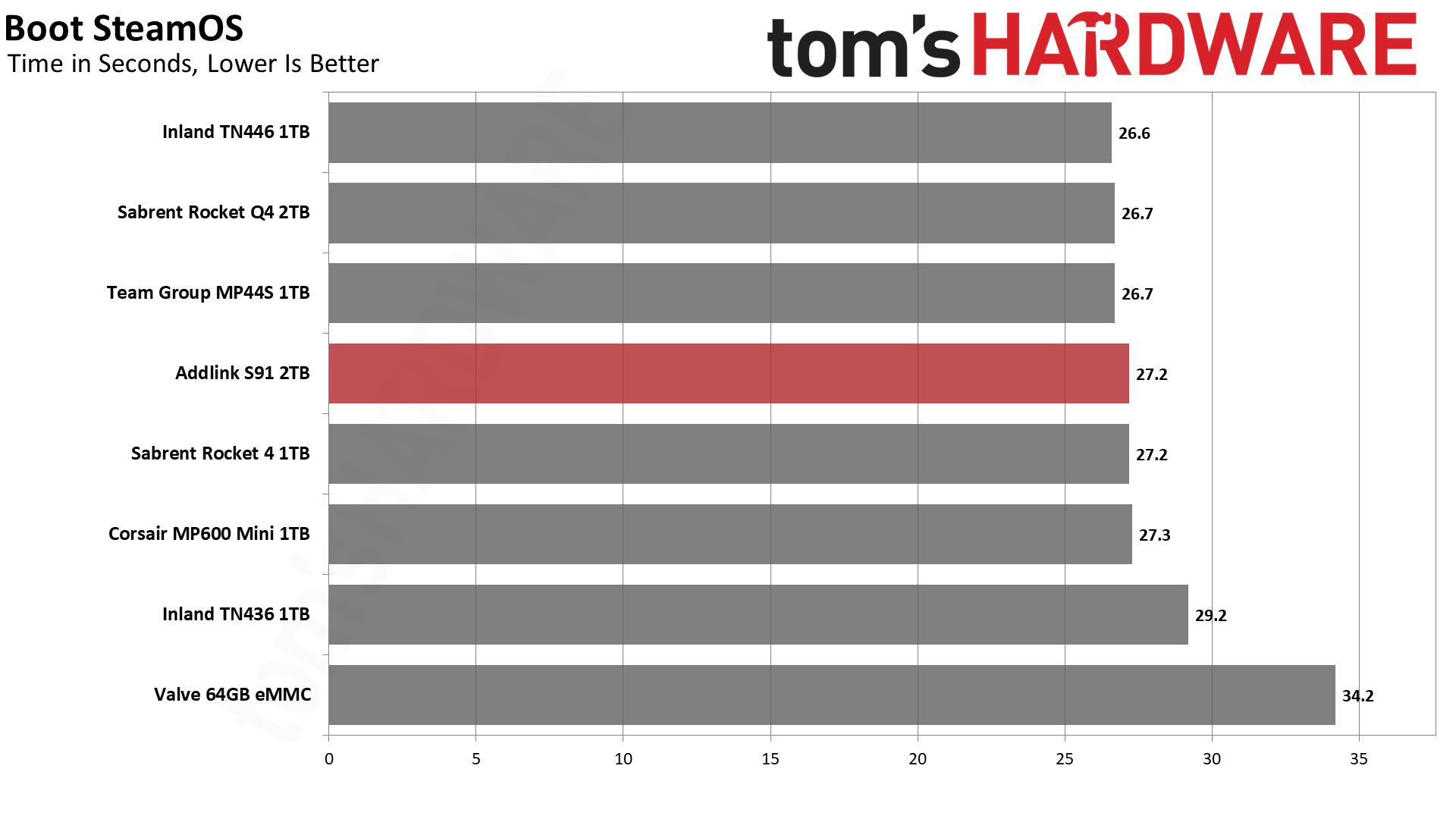
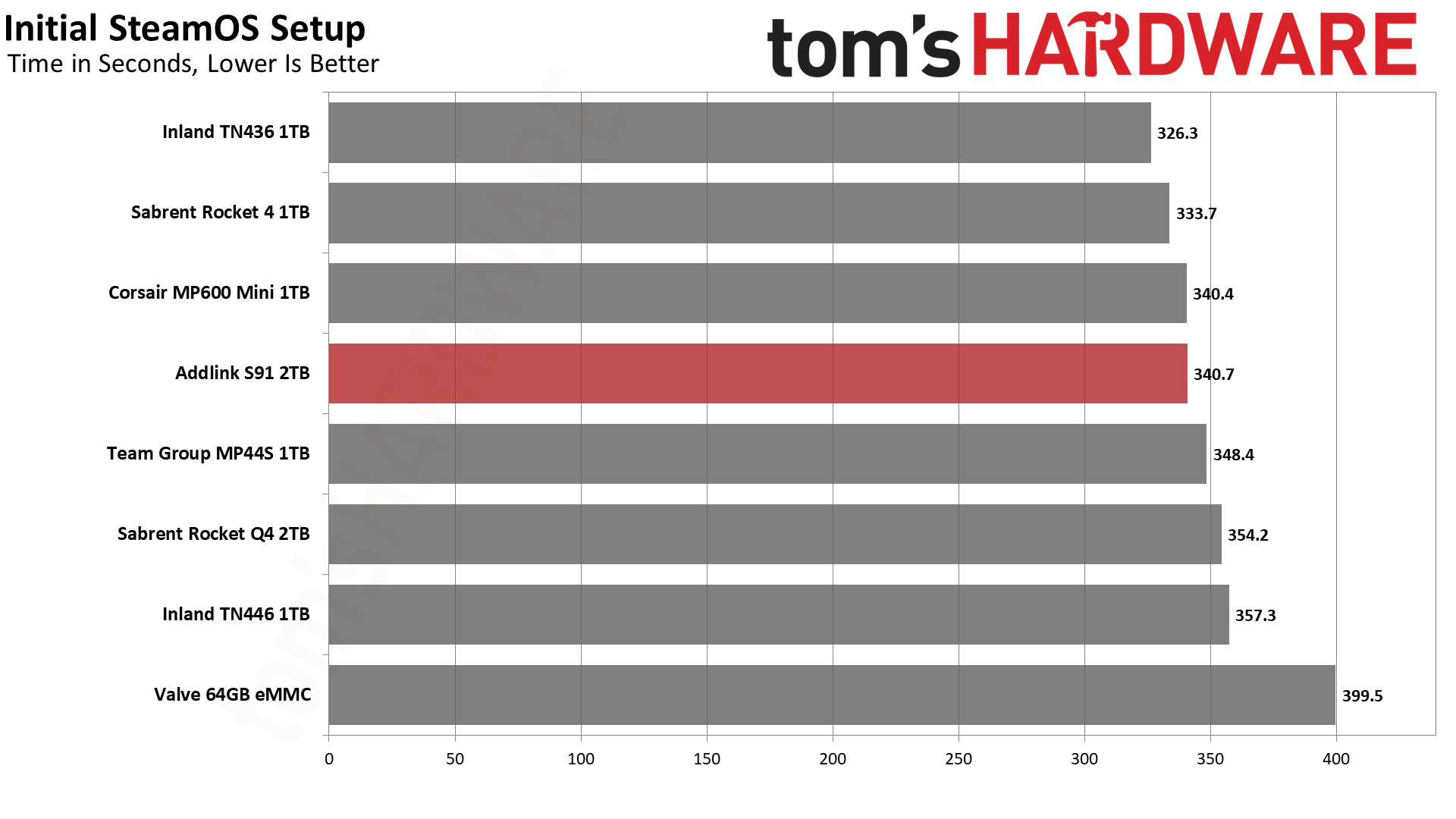
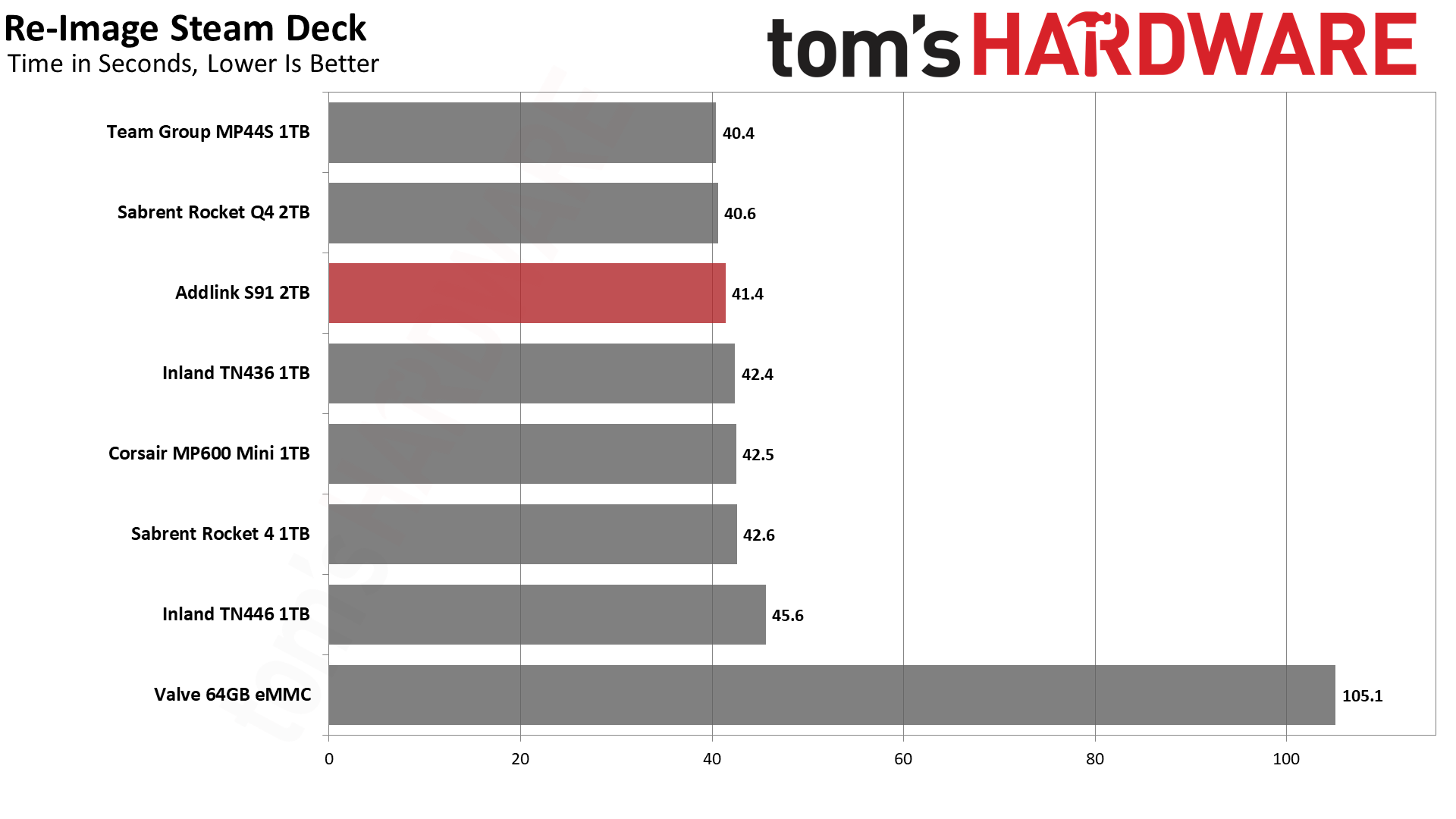
The S91 is average to above average on the whole in general Deck testing. This is a good result for a drive with QLC flash, demonstrating that there are few real-world compromises when transitioning from TLC flash to QLC. There are some edge cases where the difference may be more obvious, such as with a very full drive.
Steam Deck - KDiskMark and Temperature
One of the most popular, if not the most popular, storage benchmarks is CrysalDiskMark (CDM), which we use in our own Windows-based SSD testing suite. This benchmark relies on Microsoft’s DiskSpd with templated test settings. CDM lets you quickly see how a drive performs against its idealized, rated specifications and the benchmark can also hint at a more “real world” feel with low queue depth I/O testing.
The Linux flavor of this benchmark, which is easy to install on the Steam Deck, is KDiskMark. The “K” refers to the KDE desktop environment used on the Deck. KDiskMark relies on the Flexible I/O tester, or FIO, instead of DiskSpd. For the temperature portion we use data from the SMART sensors on the drive which can be directly polled and from which the maximum temperature can be extracted.
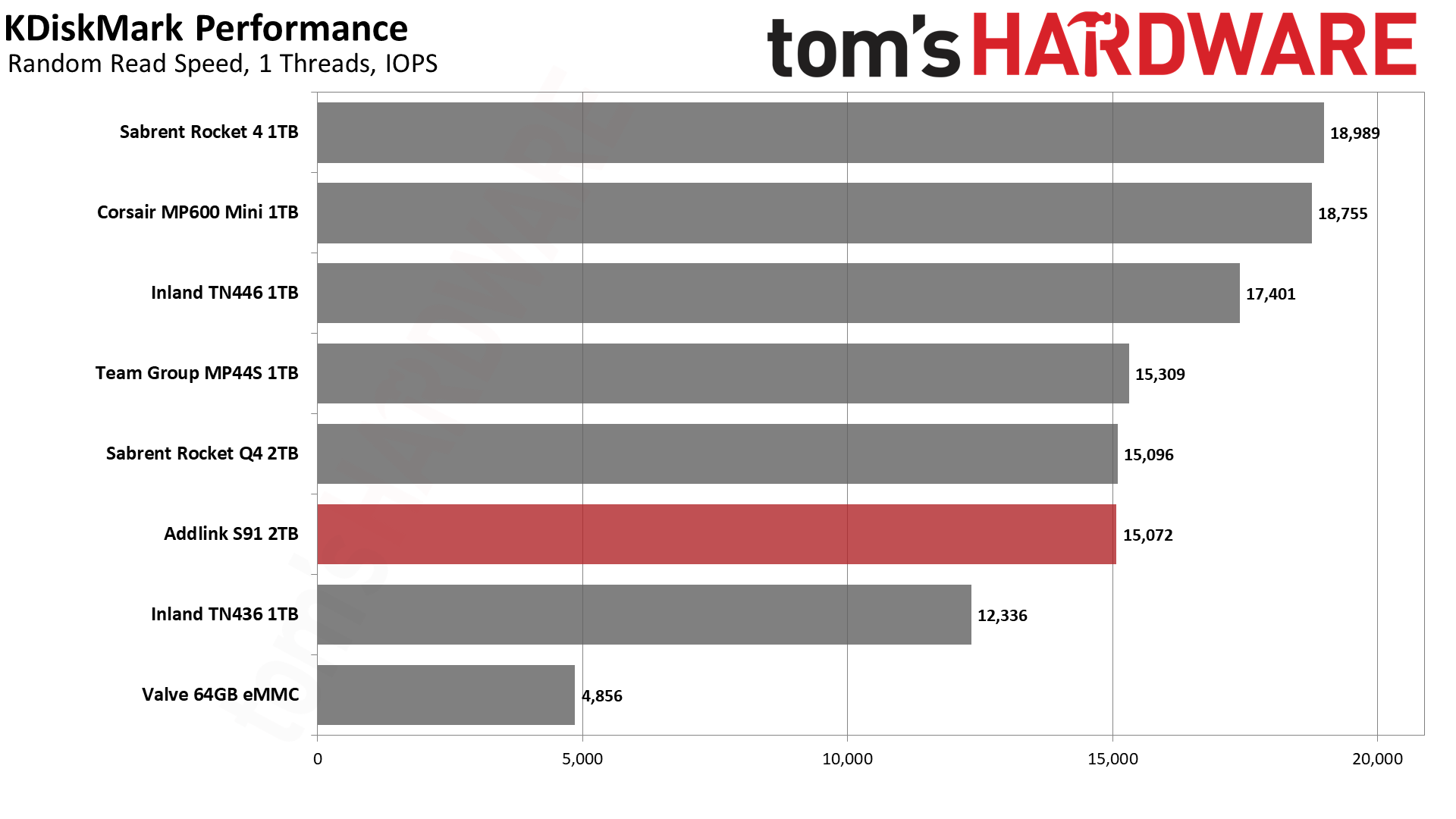
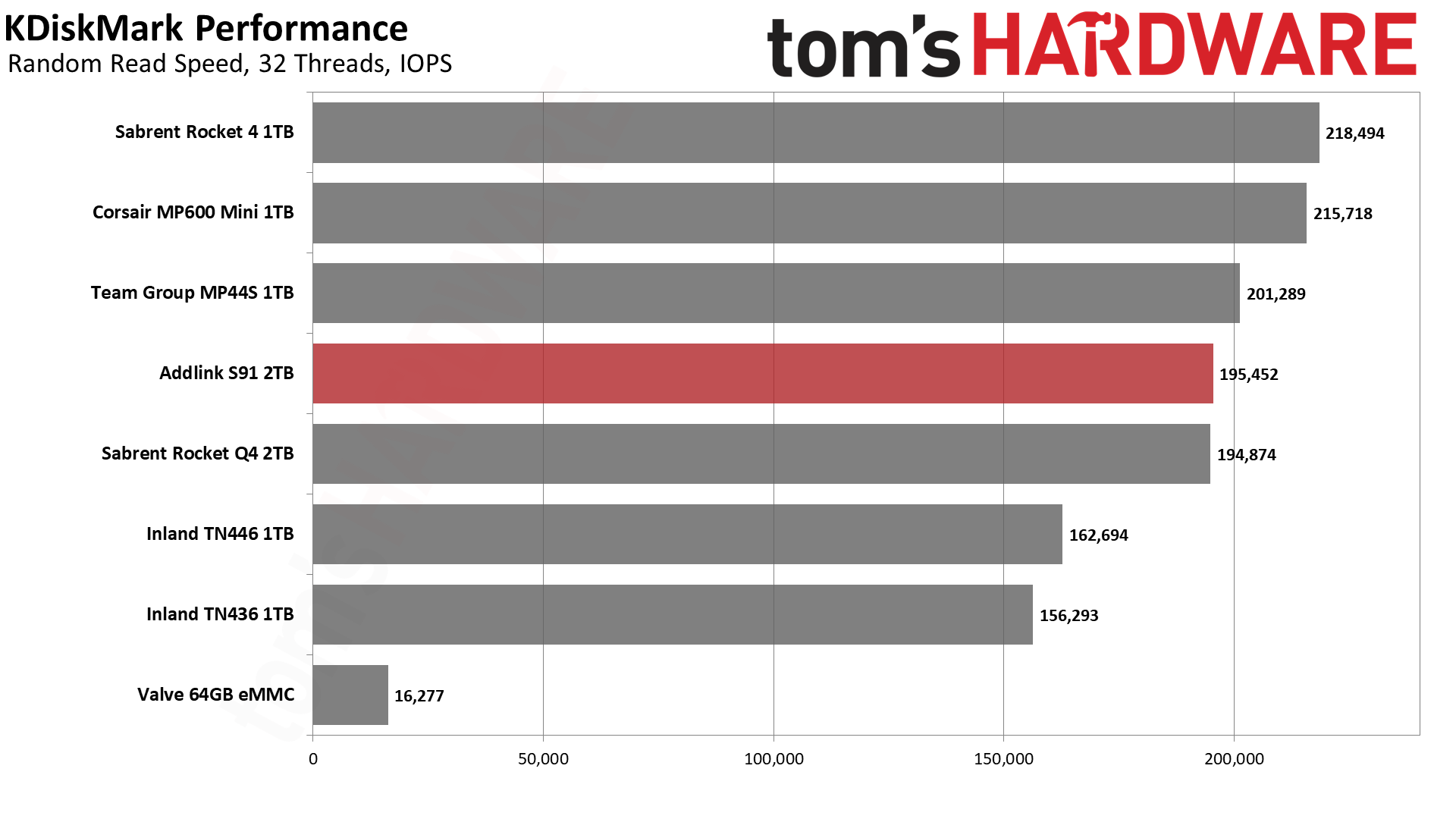
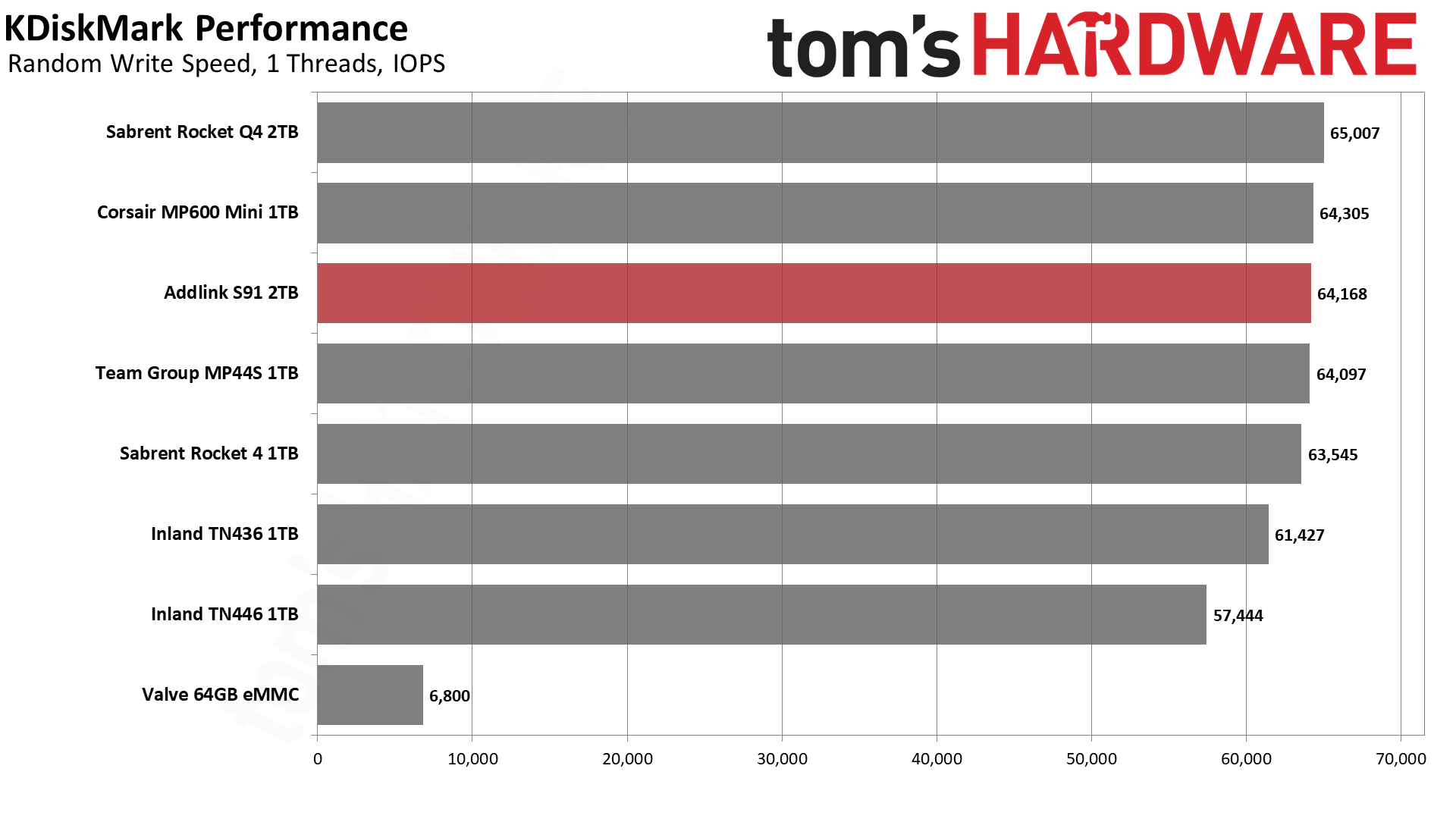
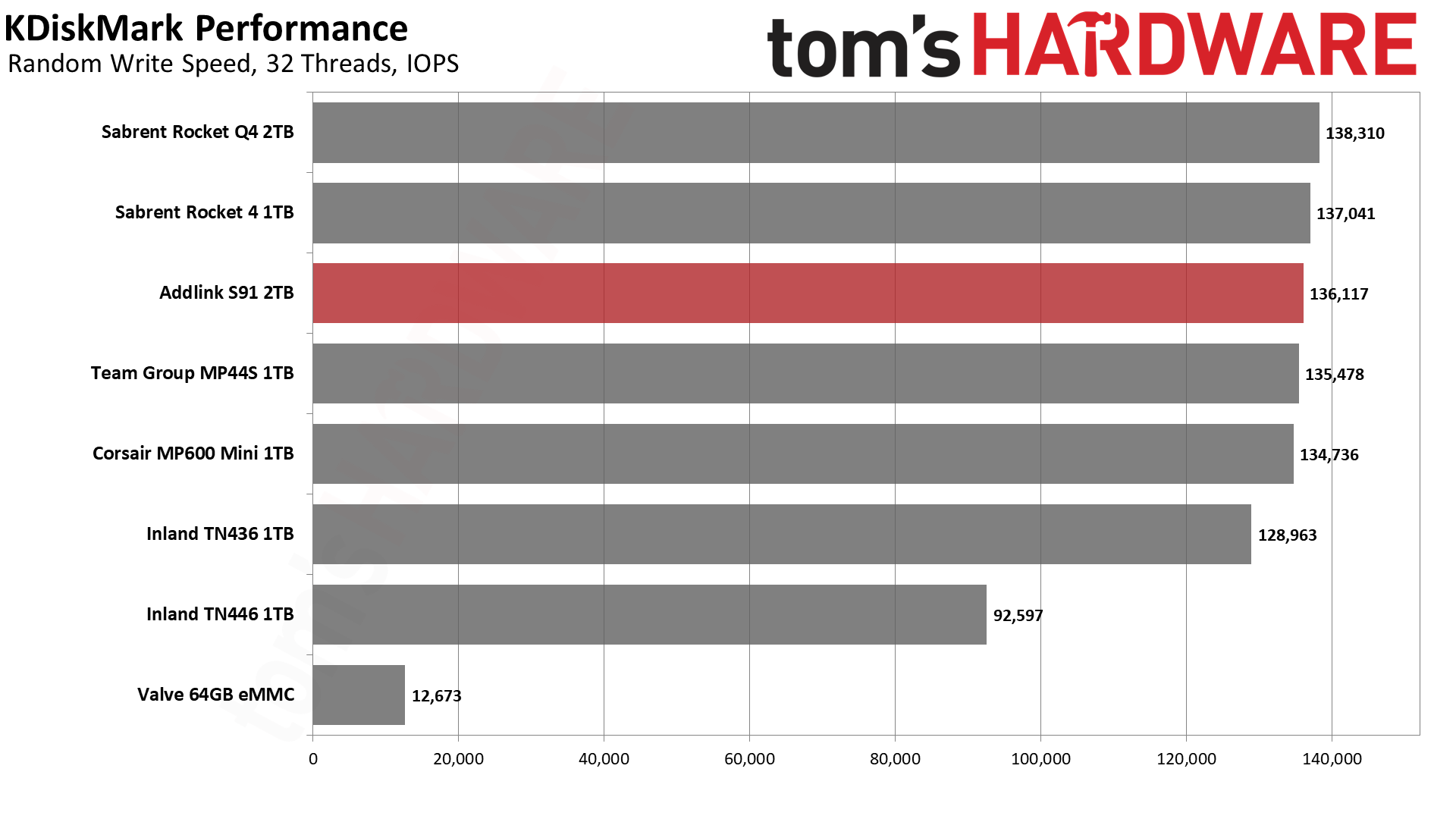


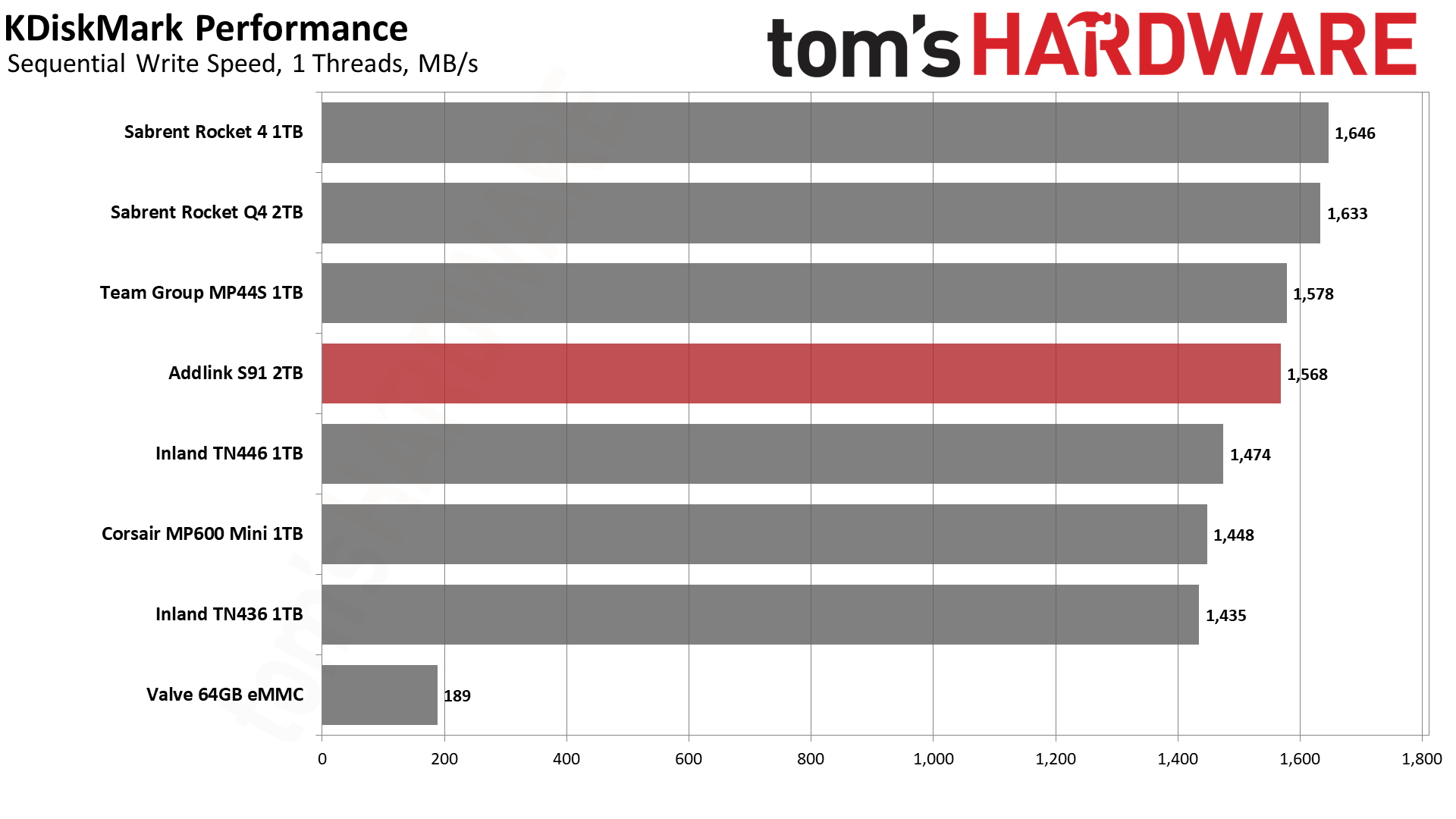
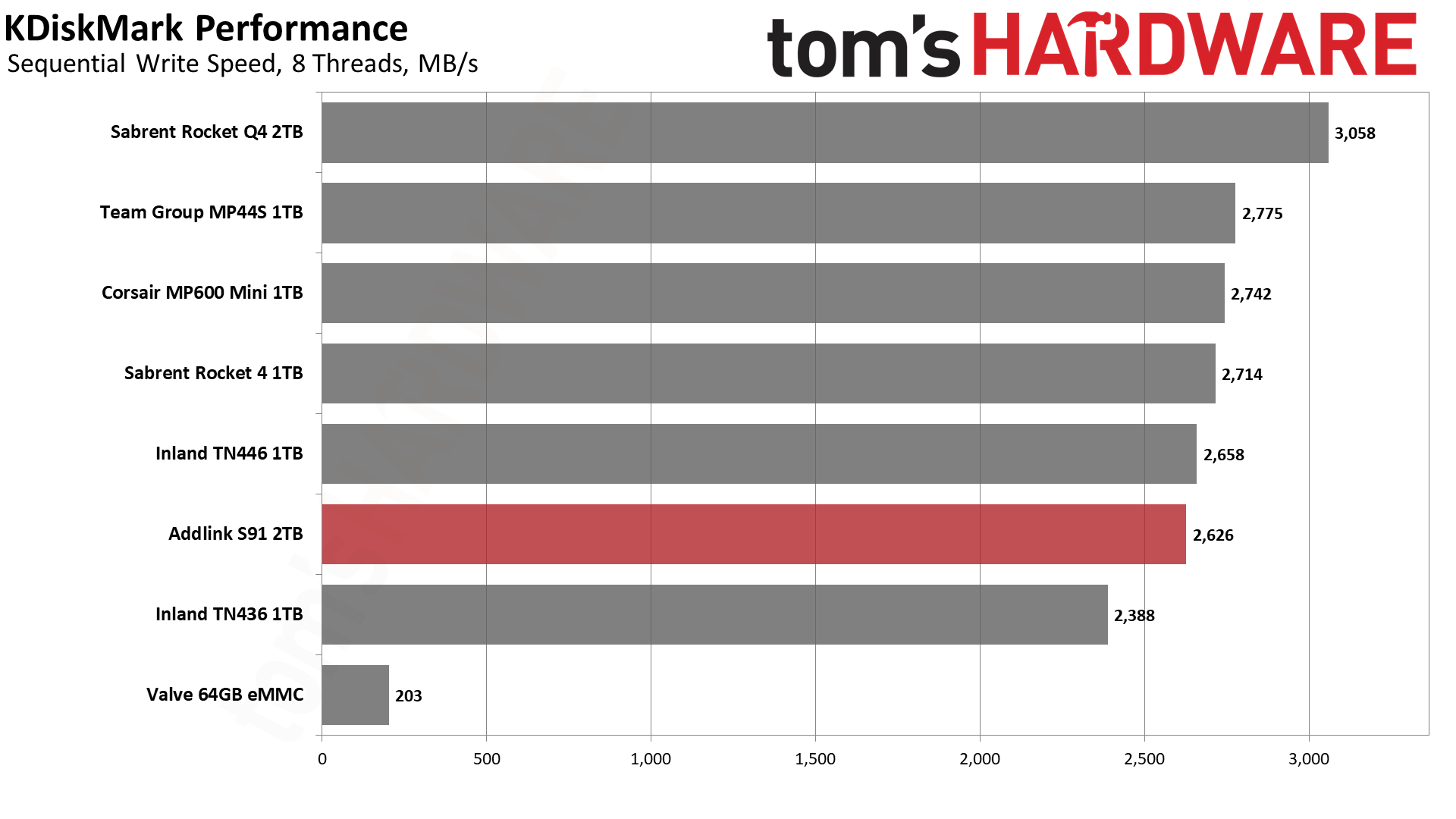
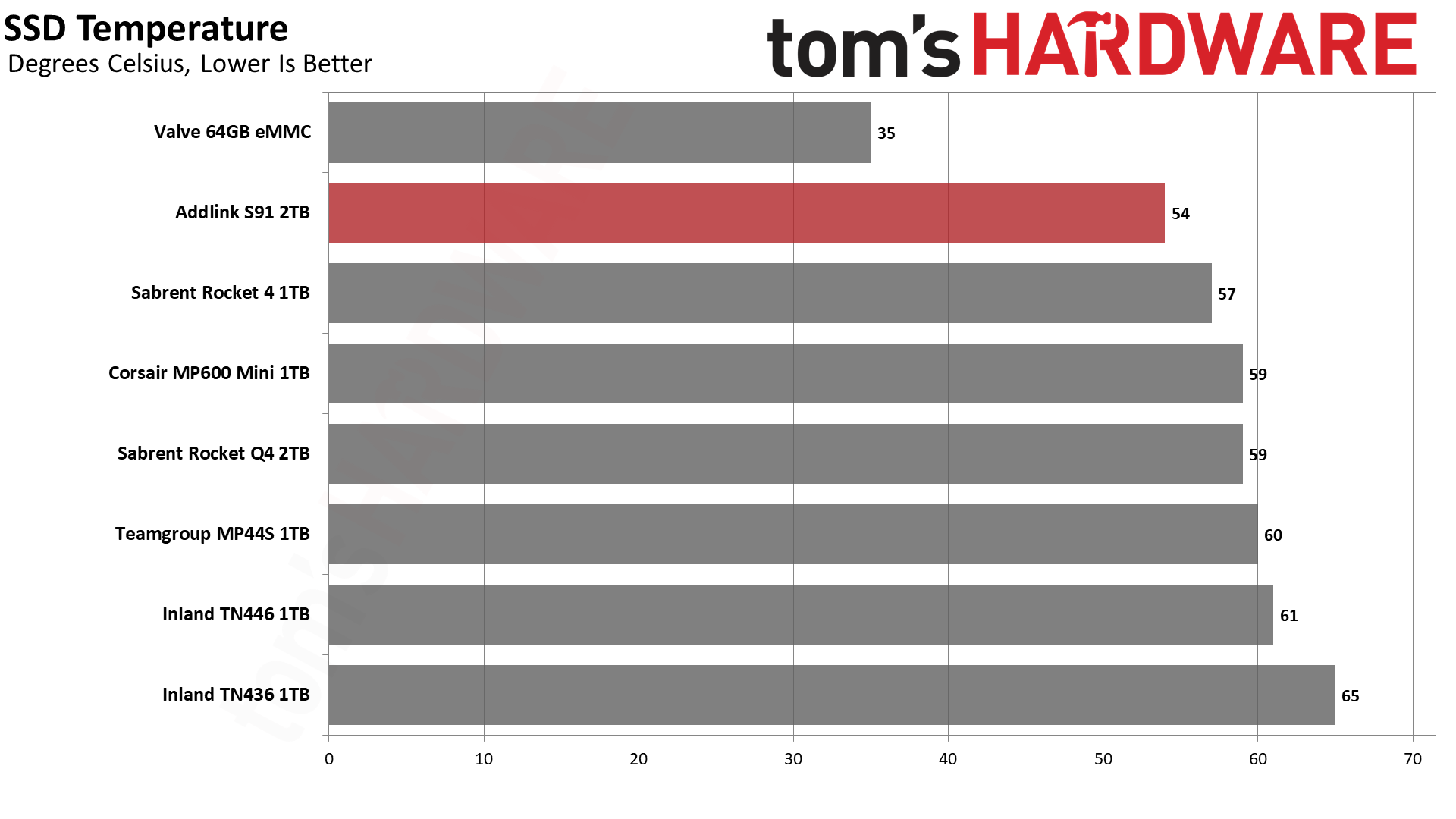
On the whole, the S91 had only average KDiskMark performance. In particular, random read performance was weak, as was the case with the QLC-based Rocket Q4 2230 and MP44S, as well. As hinted above, Some performance gaps will be larger when tested in a PCIe 4.0 machine like the ASUS ROG Ally.
The S91 is the coolest running non-stock drive that we have yet tested. There will be some variance, plus decisions like how the drive label is manufactured can impact thermal performance somewhat. Drives that perform worse may also get less hot compared to similar hardware, which does not apply to the TN436 as it uses an older controller and older flash that is objectively less efficient.
Get Tom's Hardware's best news and in-depth reviews, straight to your inbox.
PC Trace Testing - 3DMark Gaming Storage Benchmark
Built for gamers, 3DMark’s Storage Benchmark focuses on real-world gaming performance. Each round in this benchmark stresses storage based on gaming activities including loading games, saving progress, installing game files, and recording gameplay video streams.
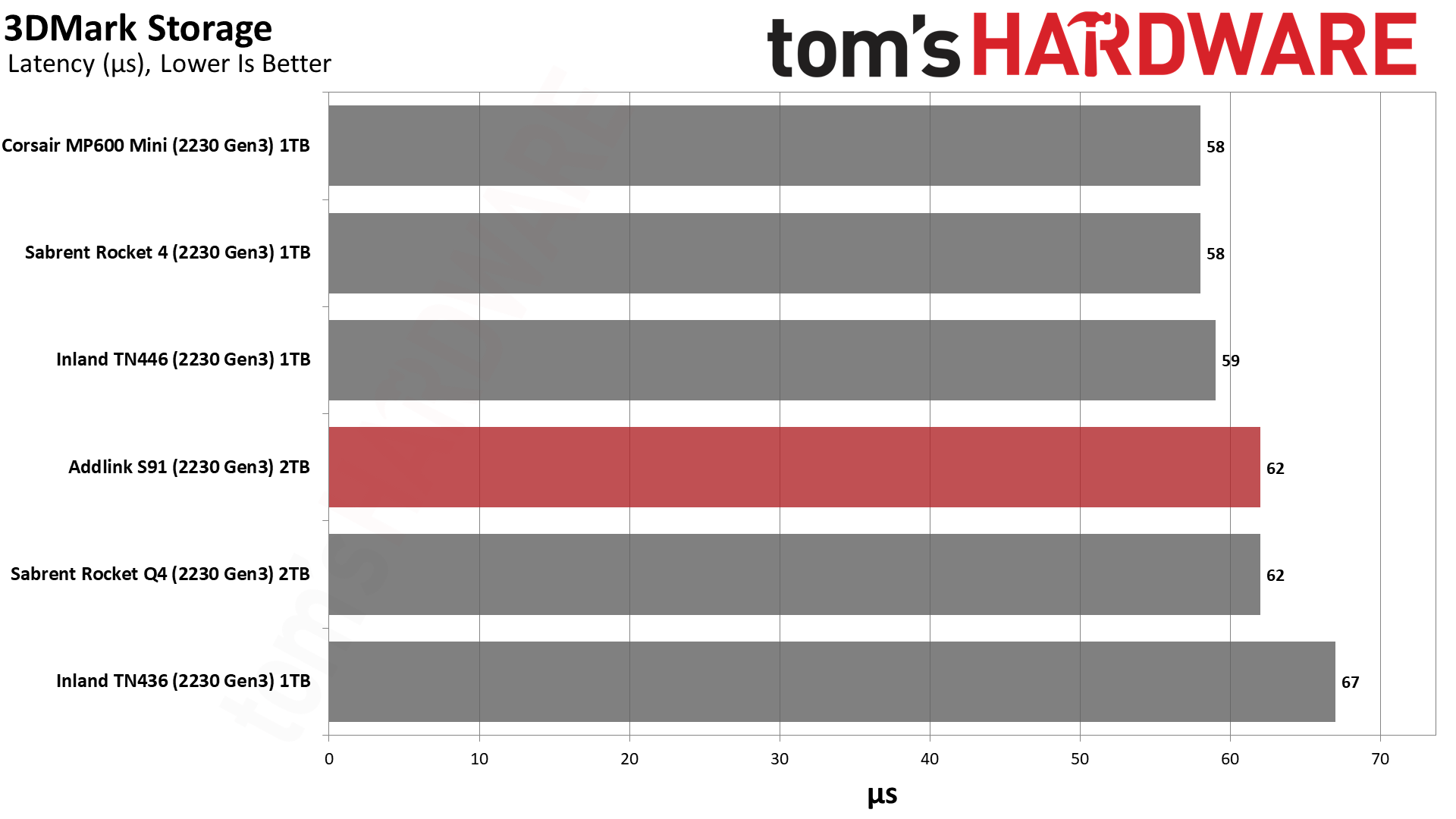
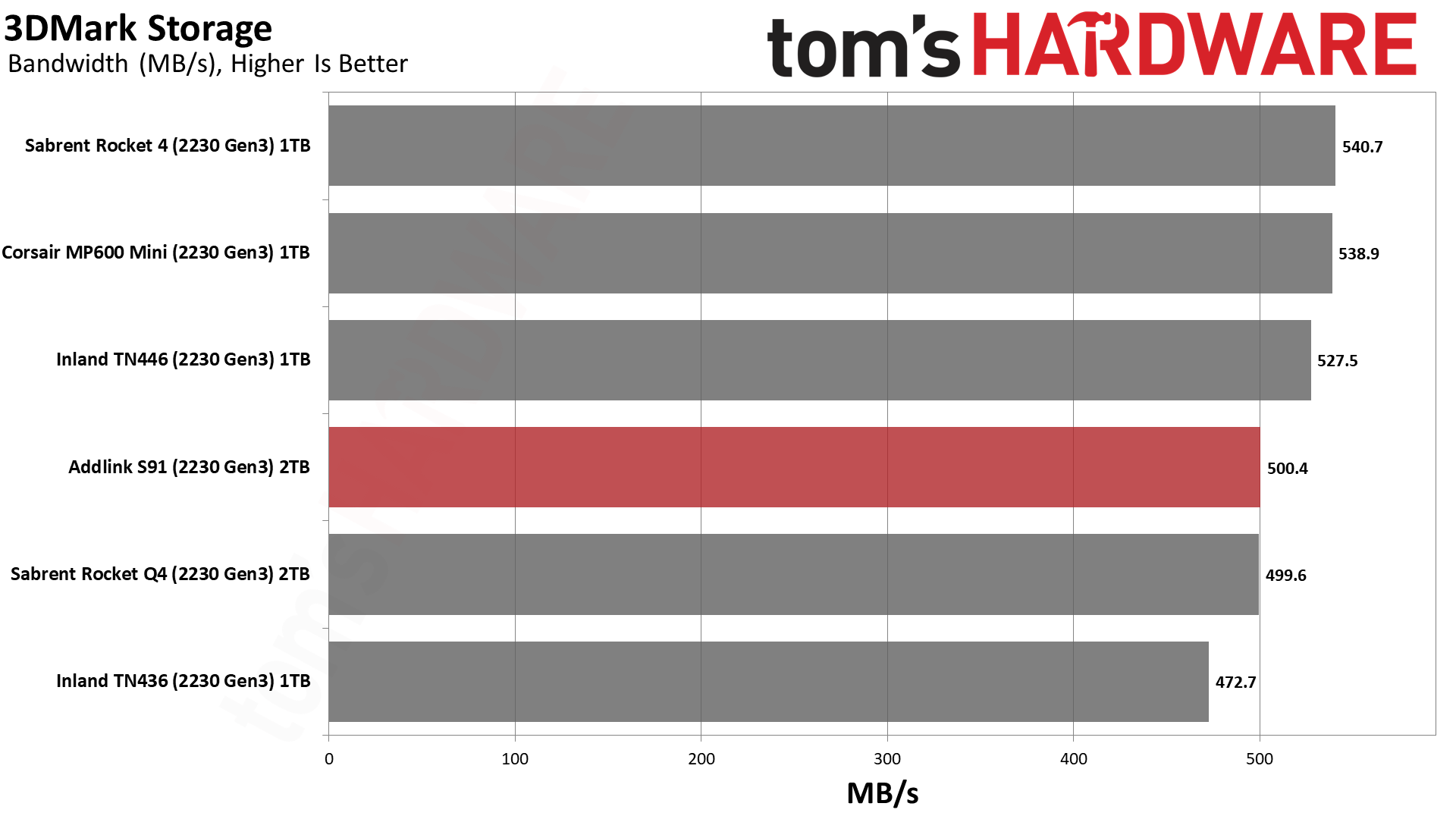
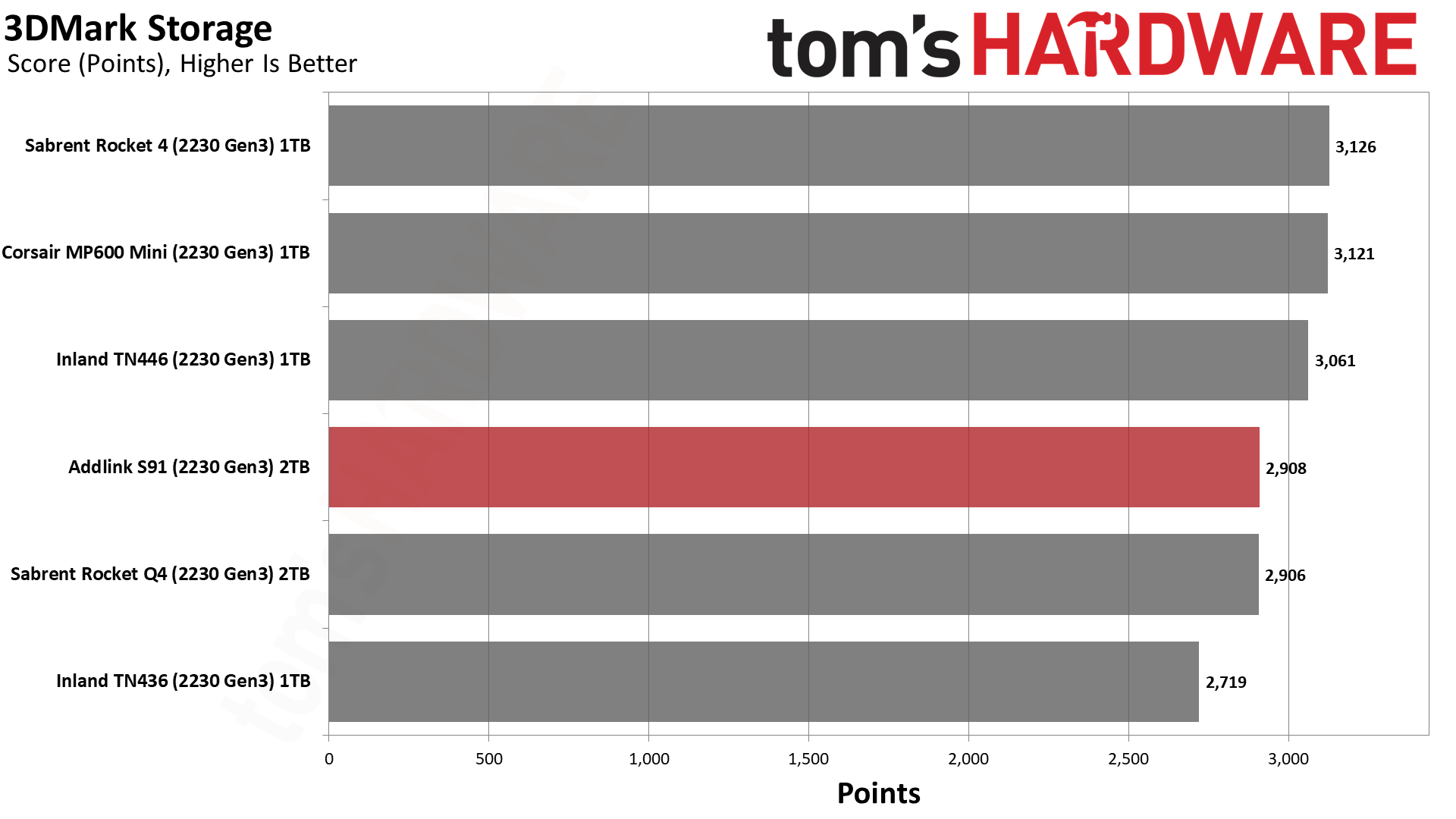

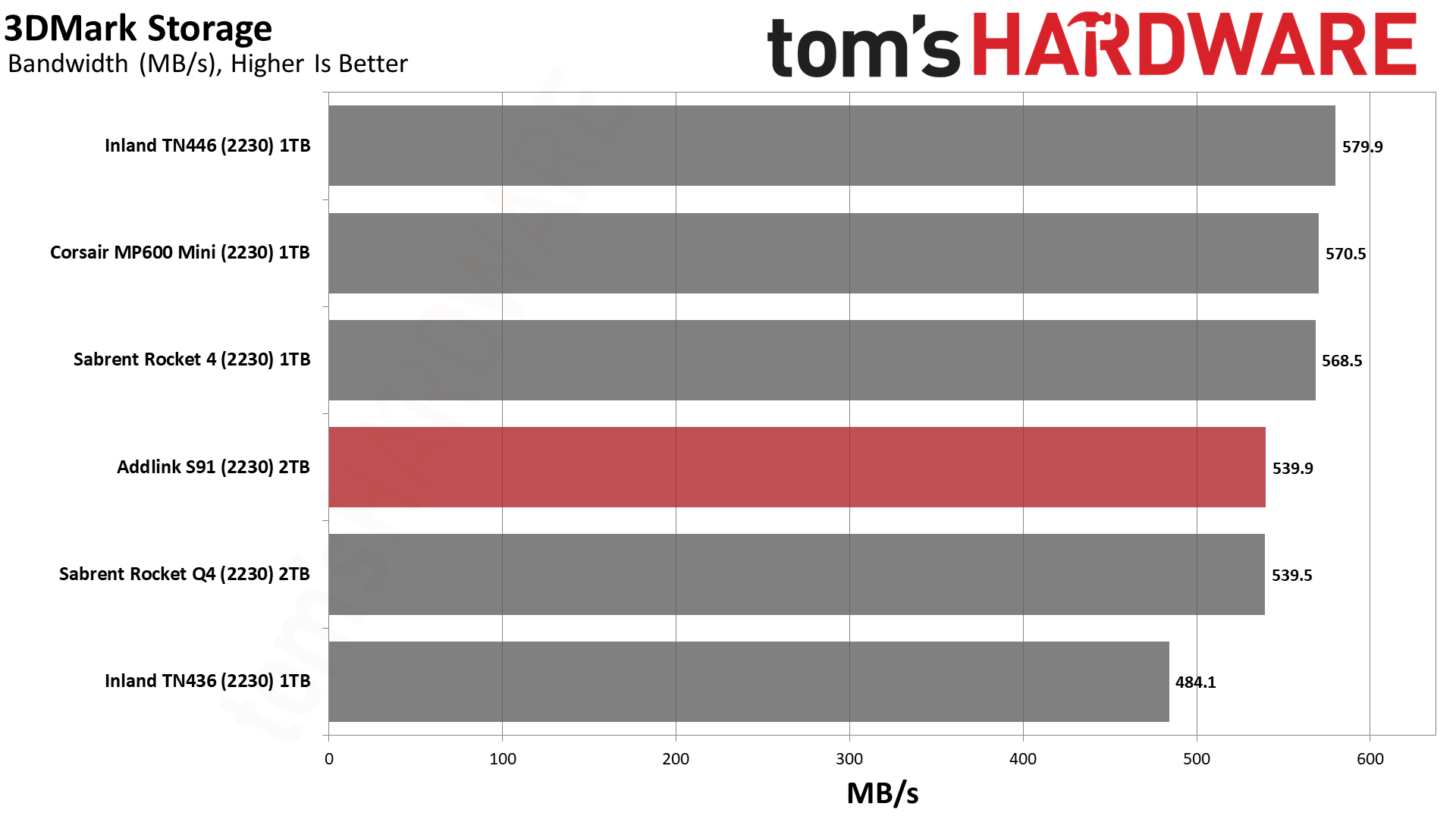
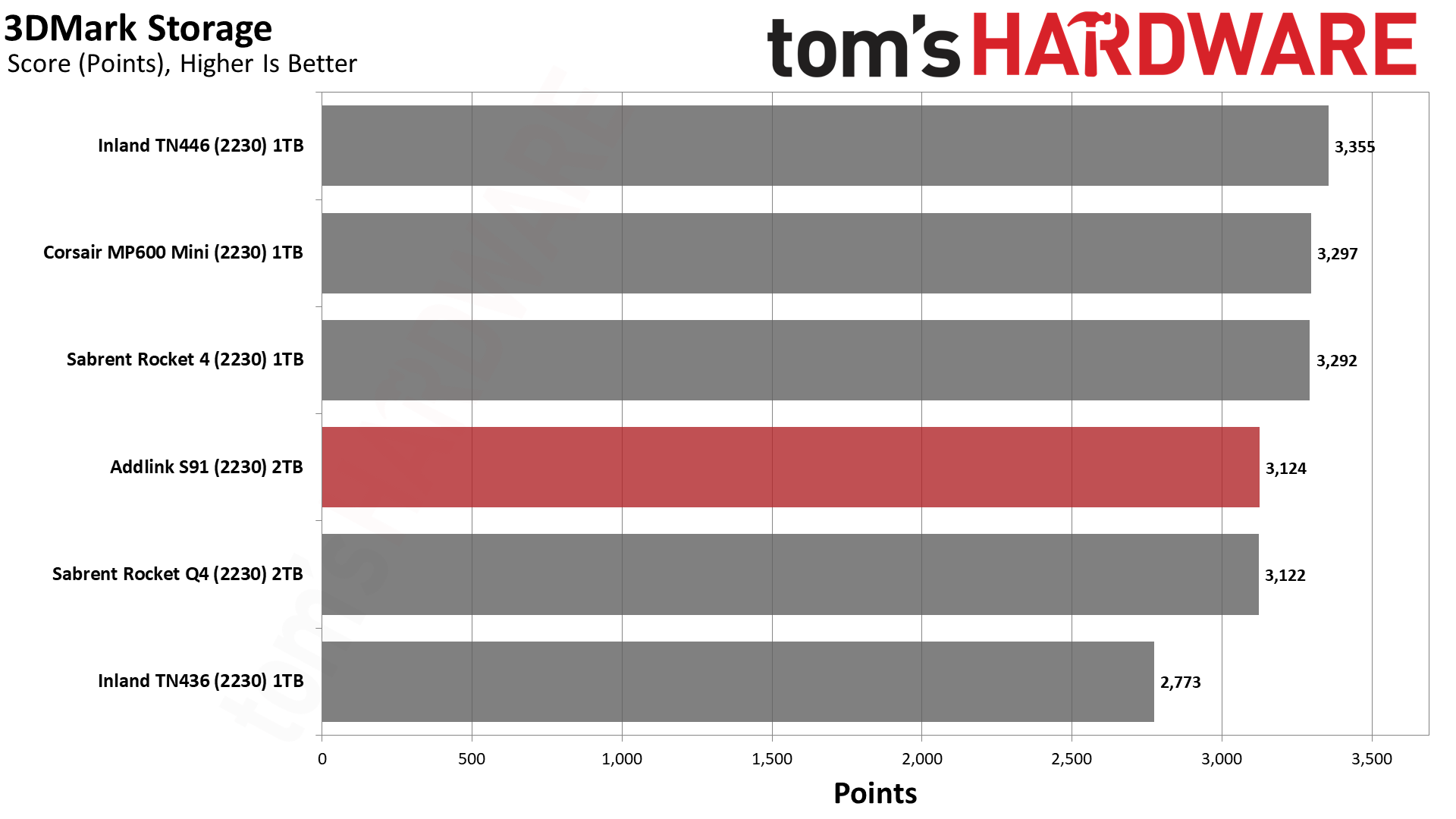
The S91 is similar to the Rocket Q4 2230, as expected. The drive places below the TLC drives, but not the older TN436. The disparity between QLC flash and TLC is not huge with either the PCIe 3.0 or 4.0 interface.
PC Trace Testing – PCMark 10 Storage Benchmark
PCMark 10 is a trace-based benchmark that uses a wide-ranging set of real-world traces from popular applications and everyday tasks to measure the performance of storage devices.


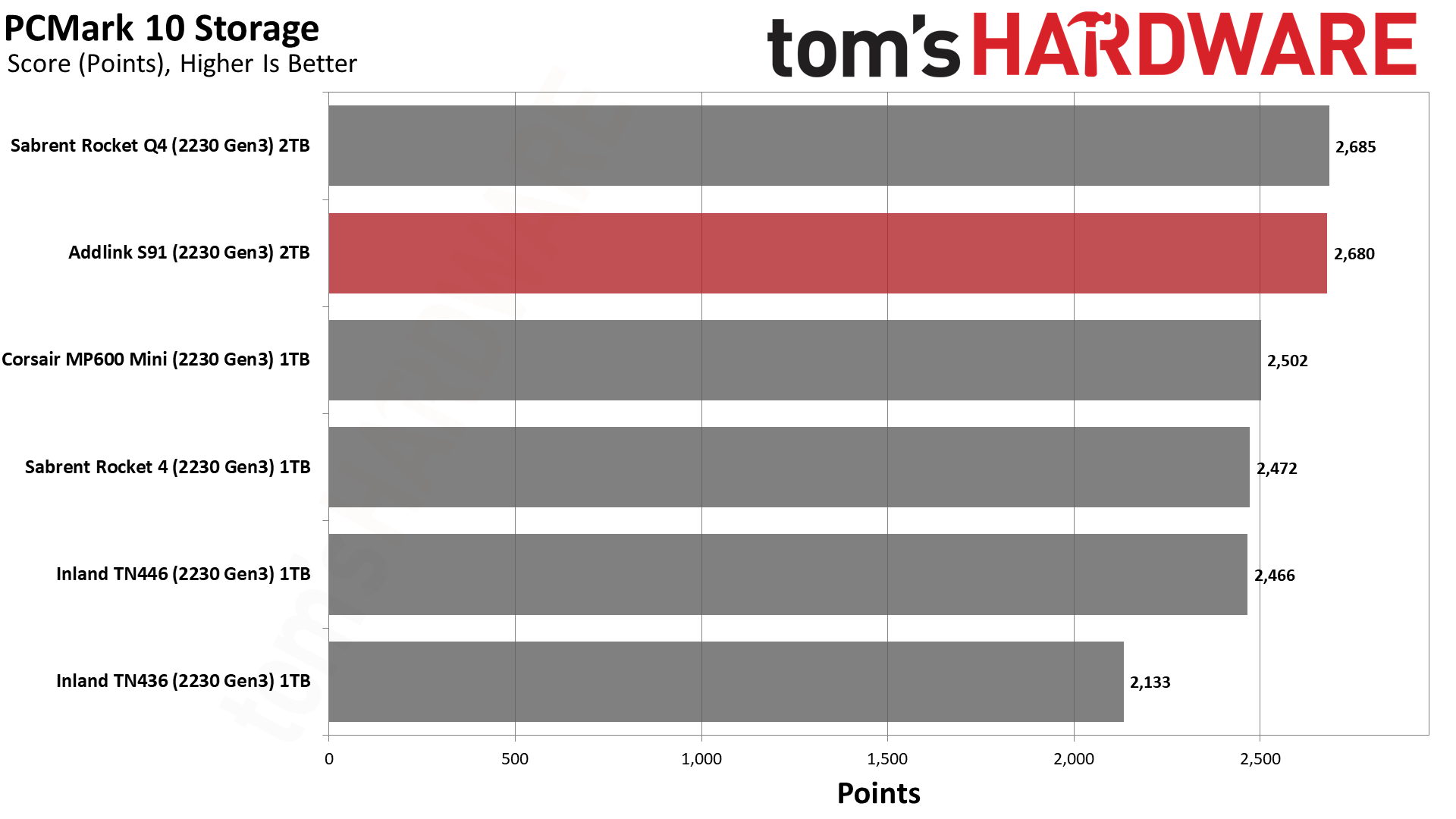
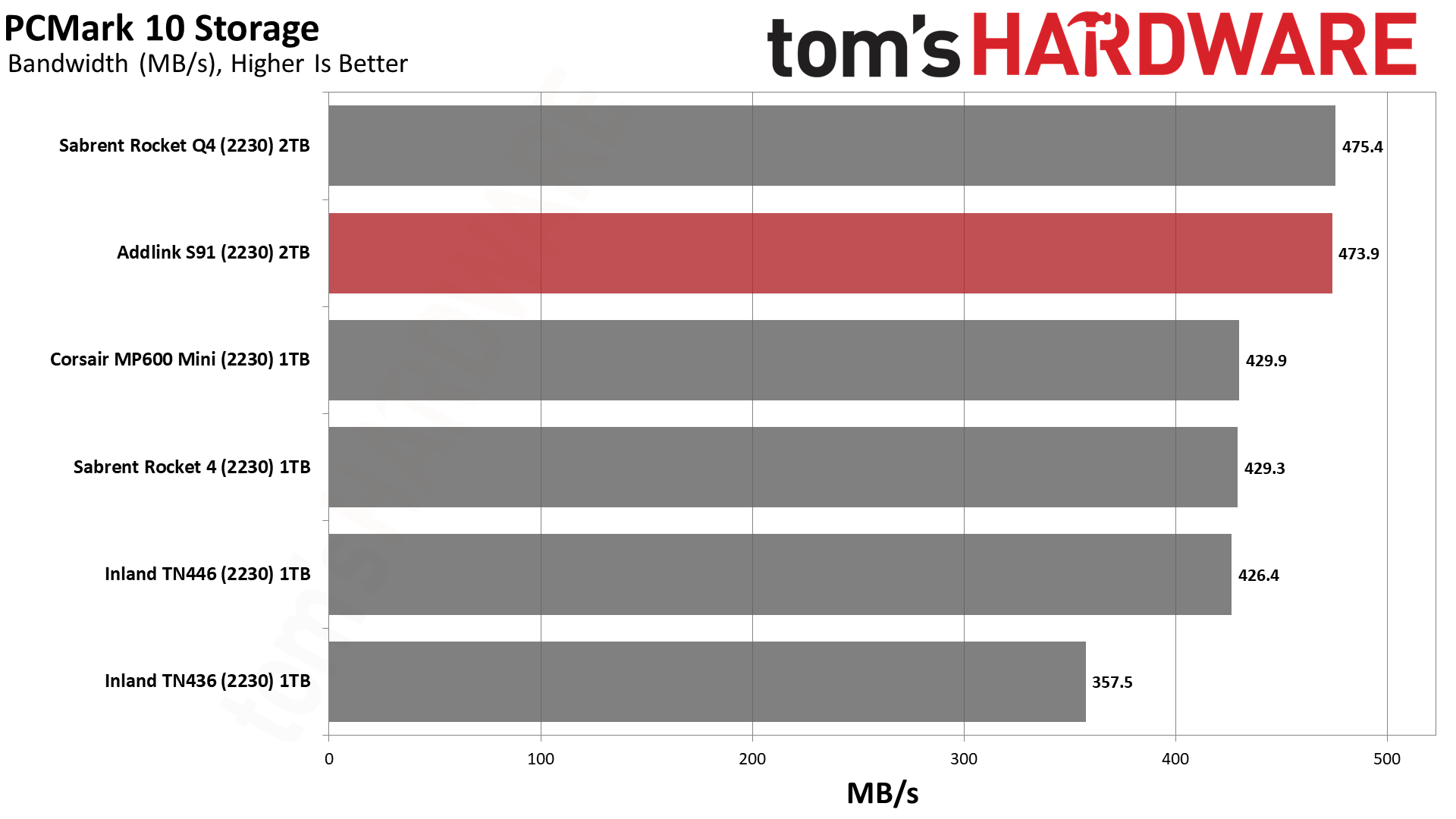
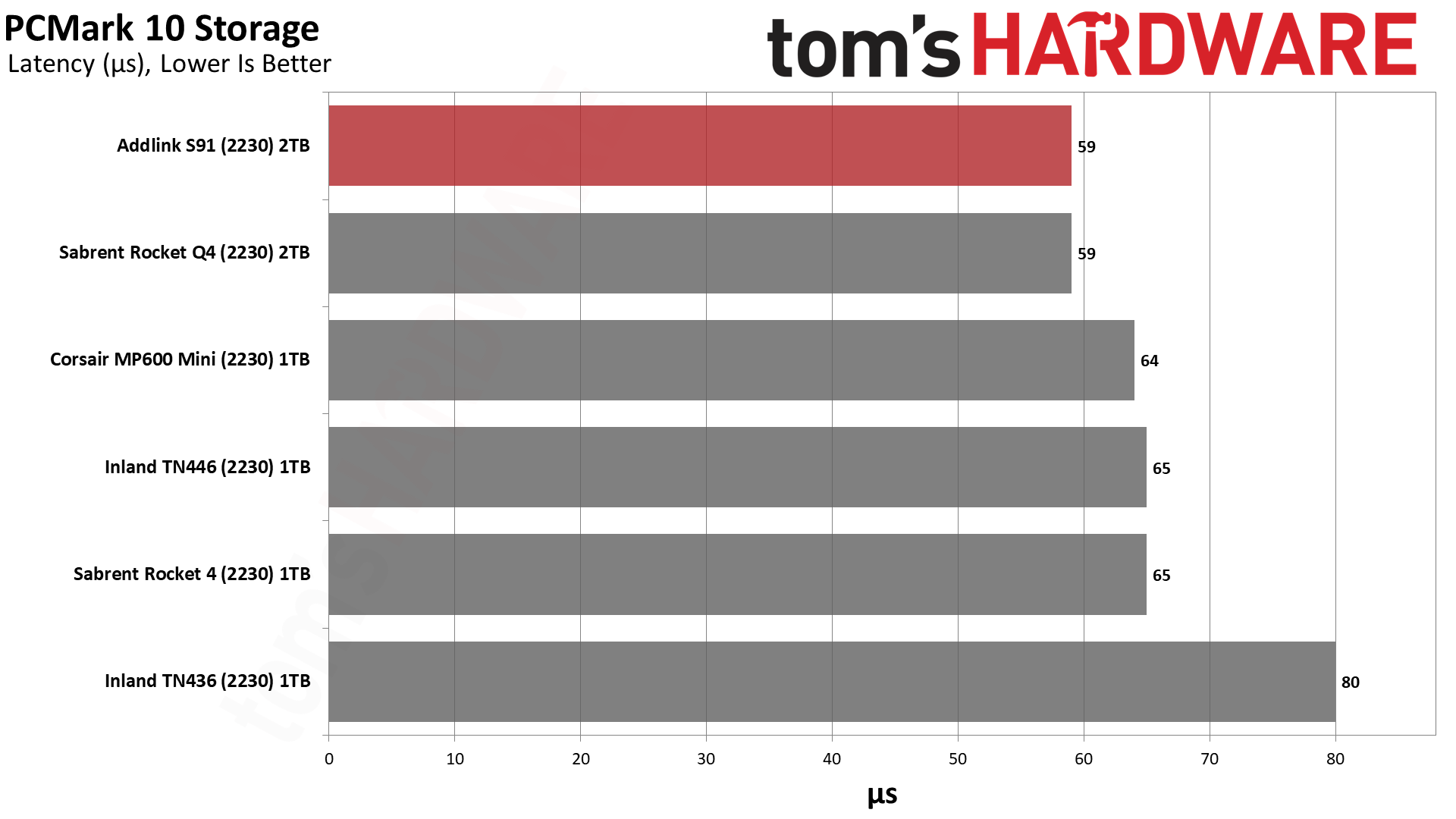
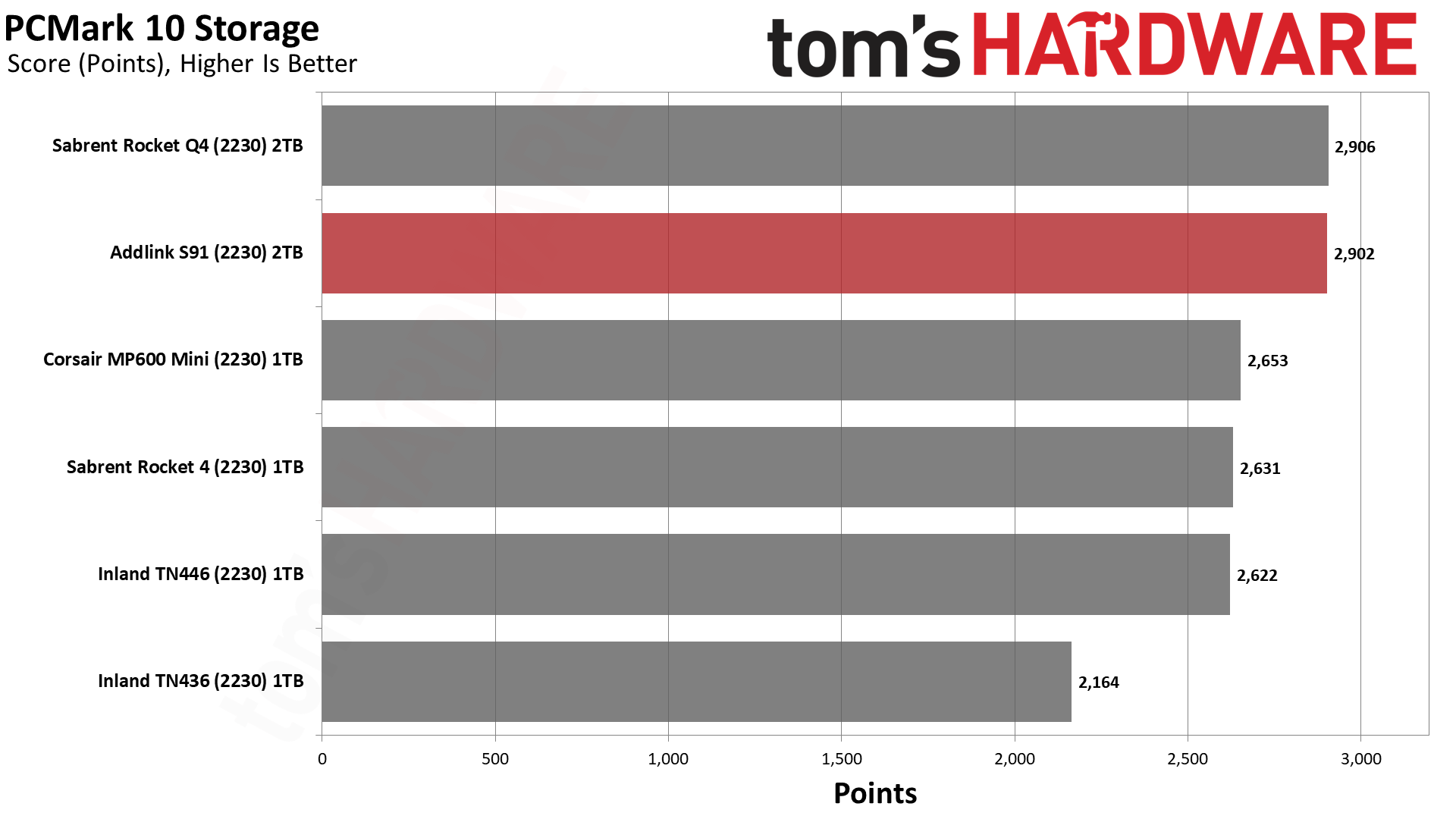
The two QLC drives, which include the S91, do well in PCMark 10. As expected, latency is better in PCIe 4.0 mode.
PC Transfer Rates – DiskBench
We use the DiskBench storage benchmarking tool to test file transfer performance with a custom, 50GB dataset. We copy 31,227 files of various types, such as pictures, PDFs, and videos to a new folder and then follow-up with a reading test of a newly-written 6.5GB zip file.
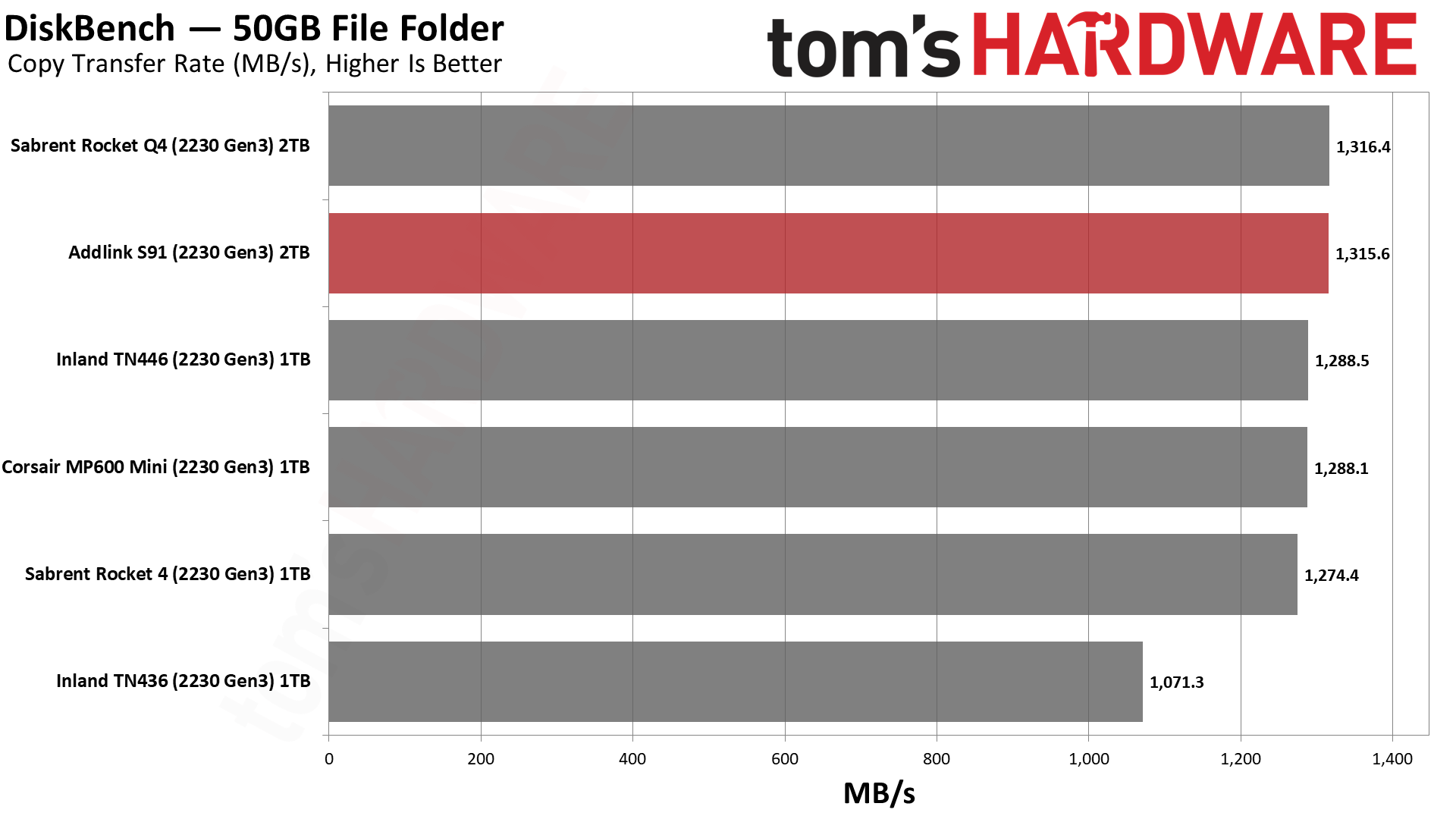
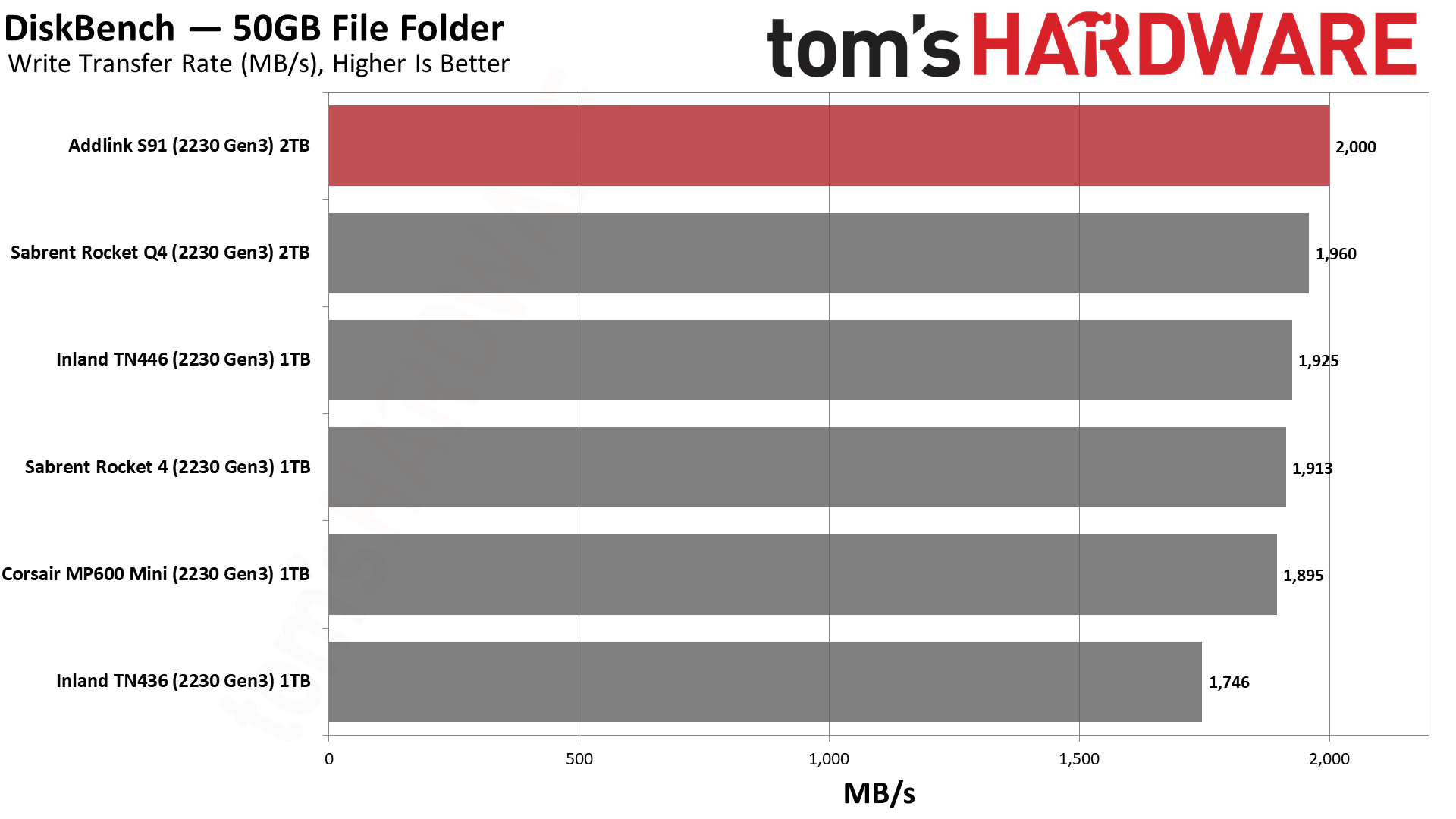
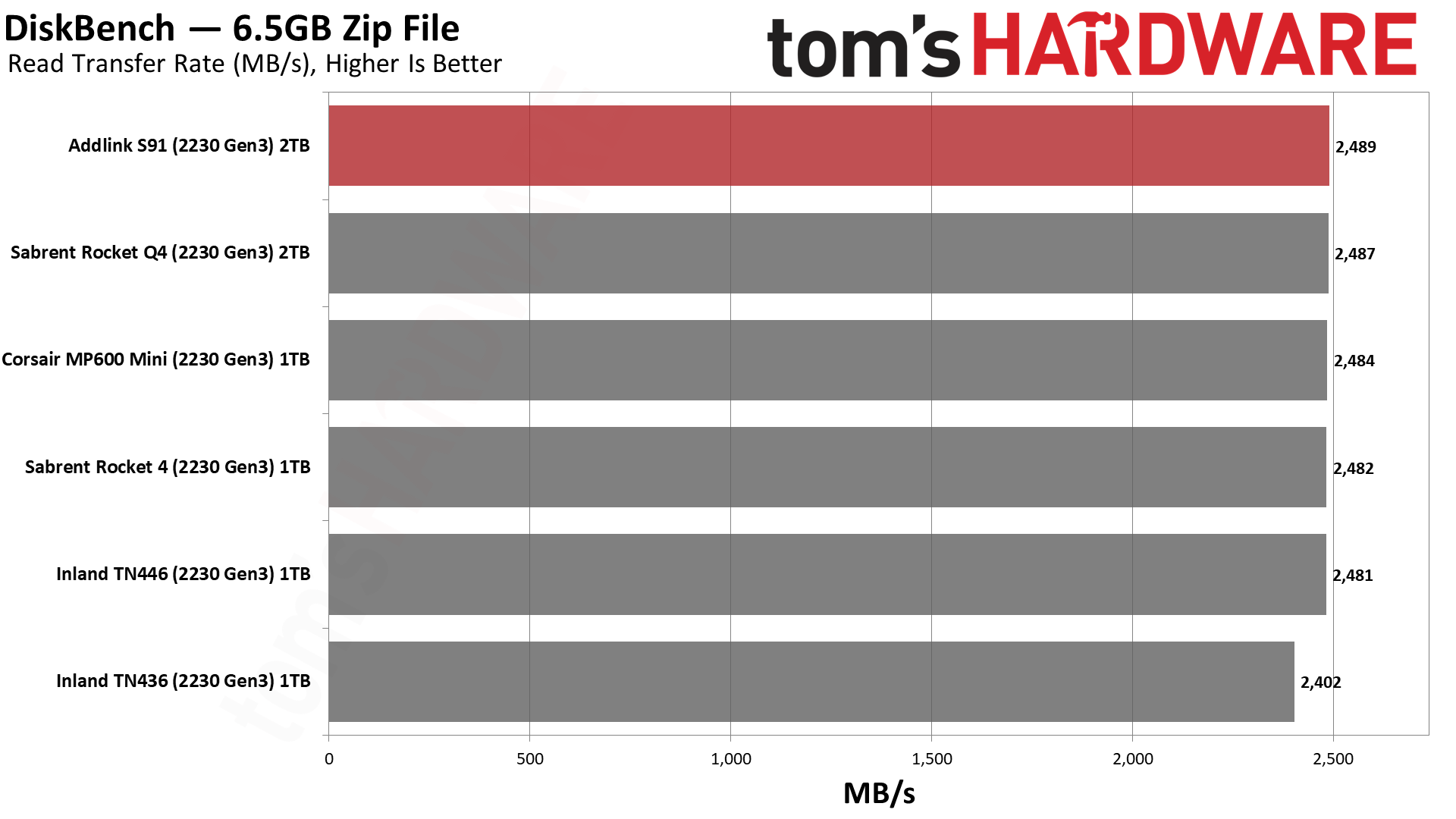
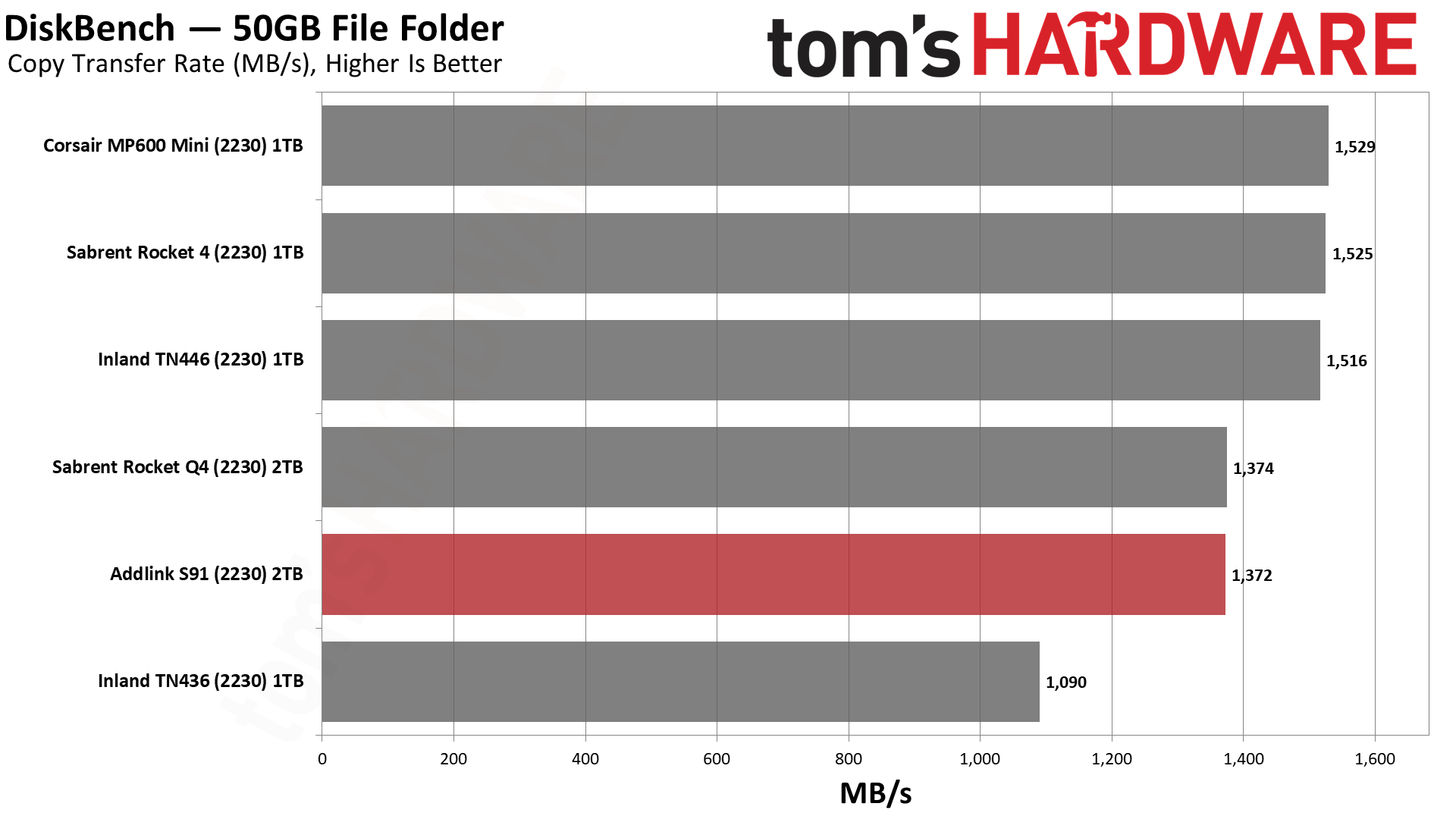


Generally speaking, QLC drives will not transfer data as fast due to having lower native write performance. This is not a prominent issue in pSLC mode and the limited interface of PCIe 3.0, the latter of which would be the case in the Steam Deck.
PCIe 3.0 has the QLC drives performing essentially equal to the TLC ones, aside from the older TN436. In PCIe 4.0 mode, as would be the case with the ROG Ally, the TLC drives do pull away a small amount.
PC Synthetic Testing - ATTO / CrystalDiskMark
ATTO and CrystalDiskMark (CDM) are free and easy-to-use storage benchmarking tools that SSD vendors commonly use to assign performance specifications to their products. Both of these tools give us insight into how each device handles different file sizes.
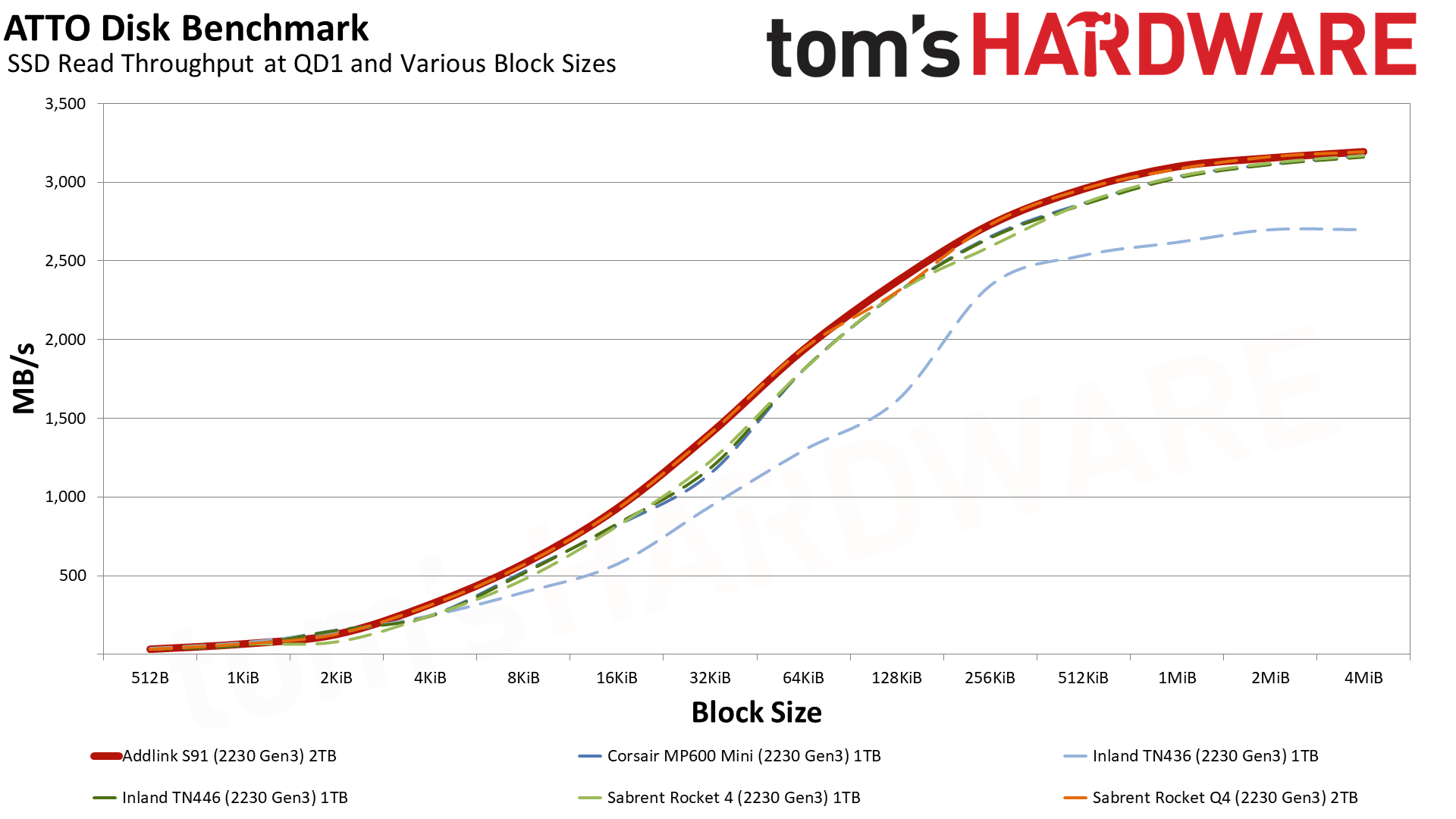


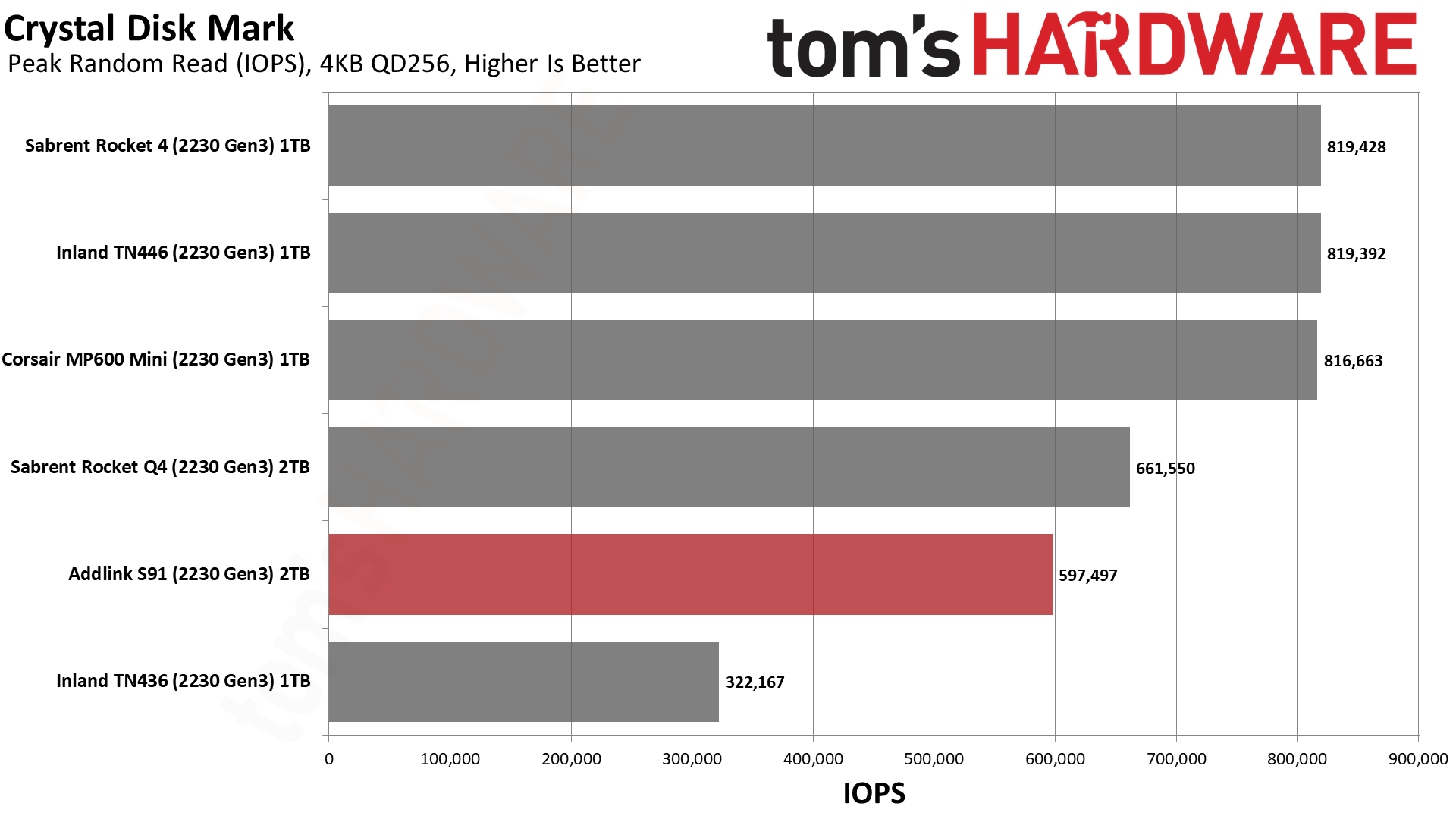
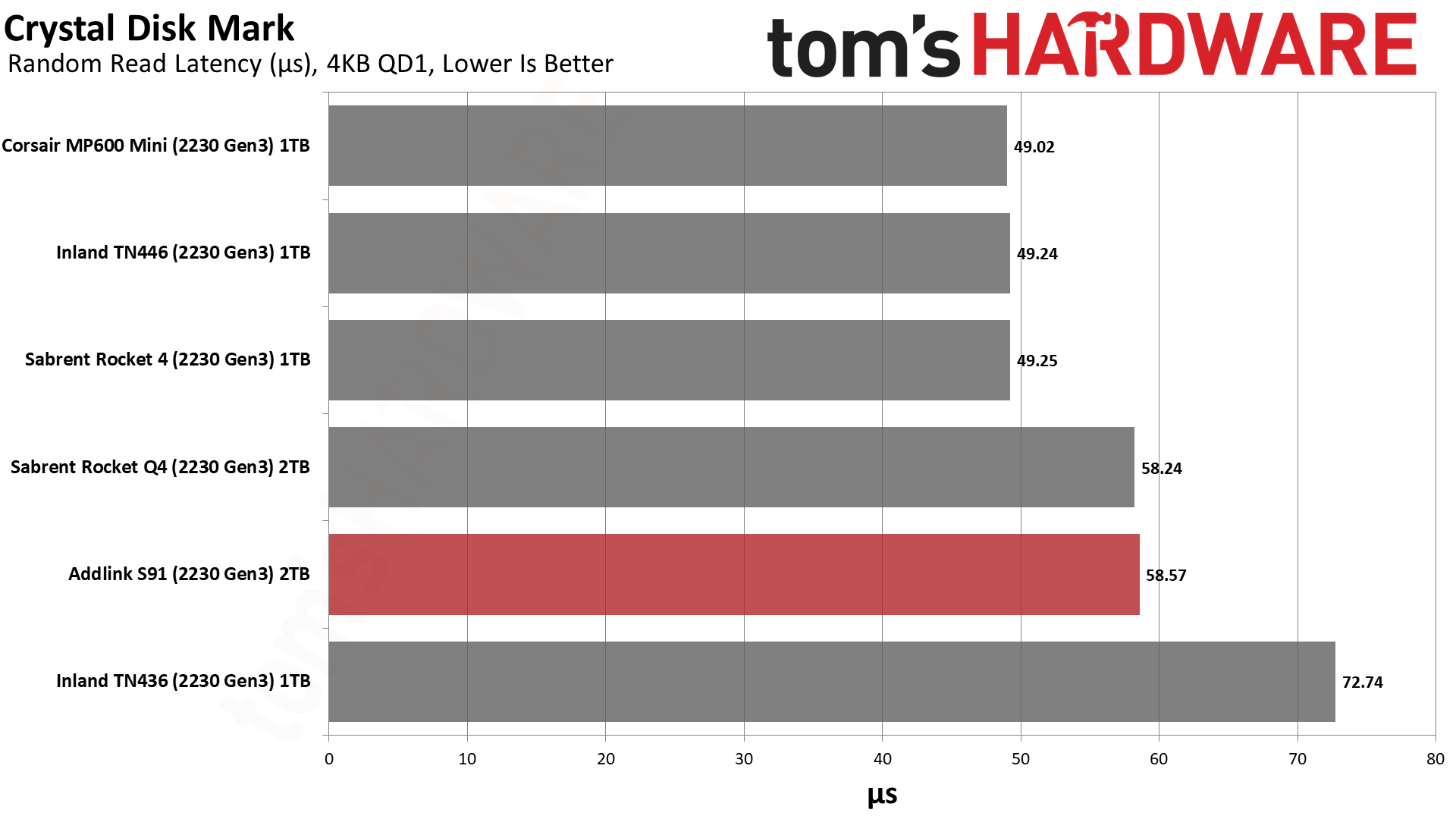
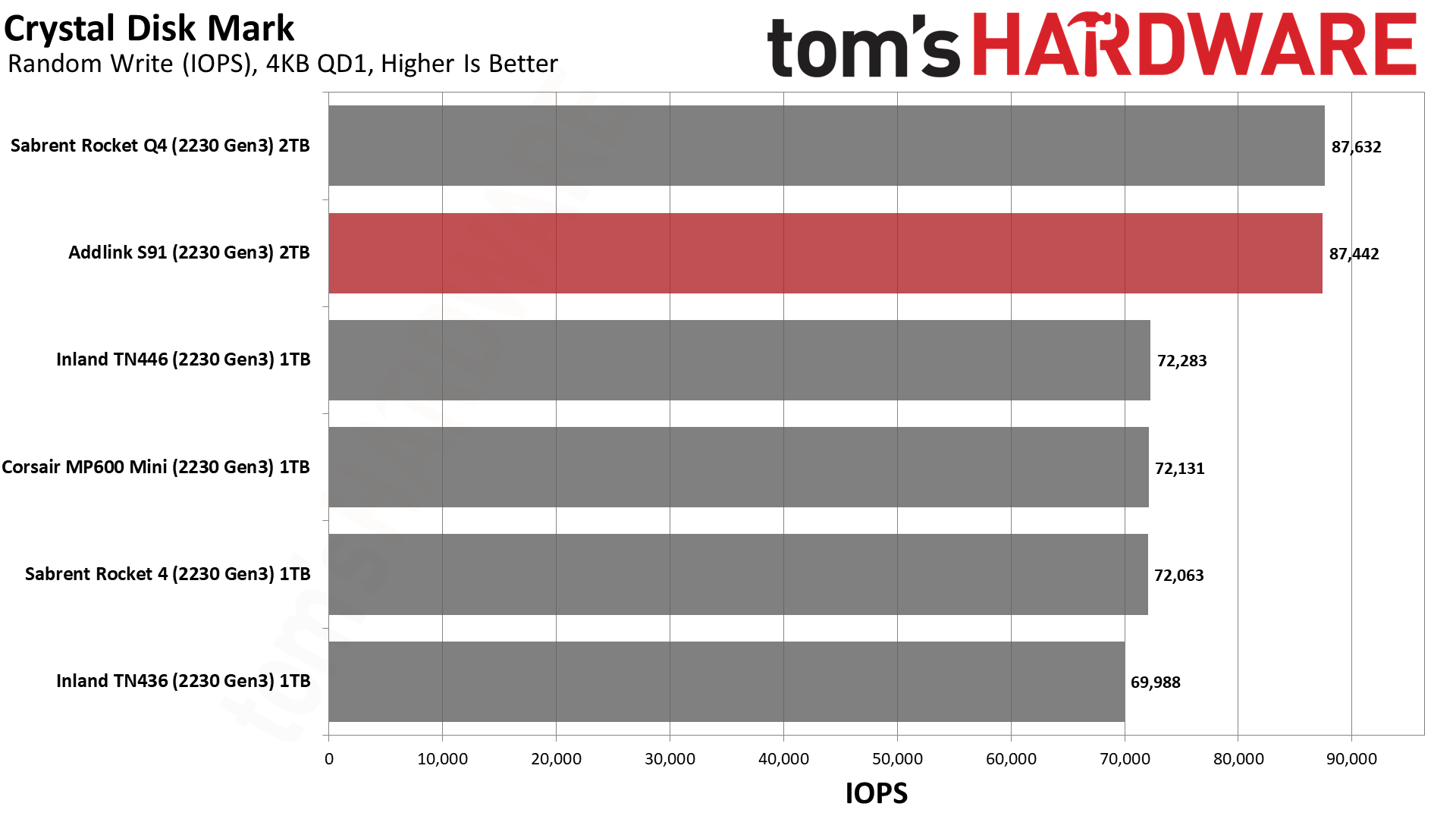
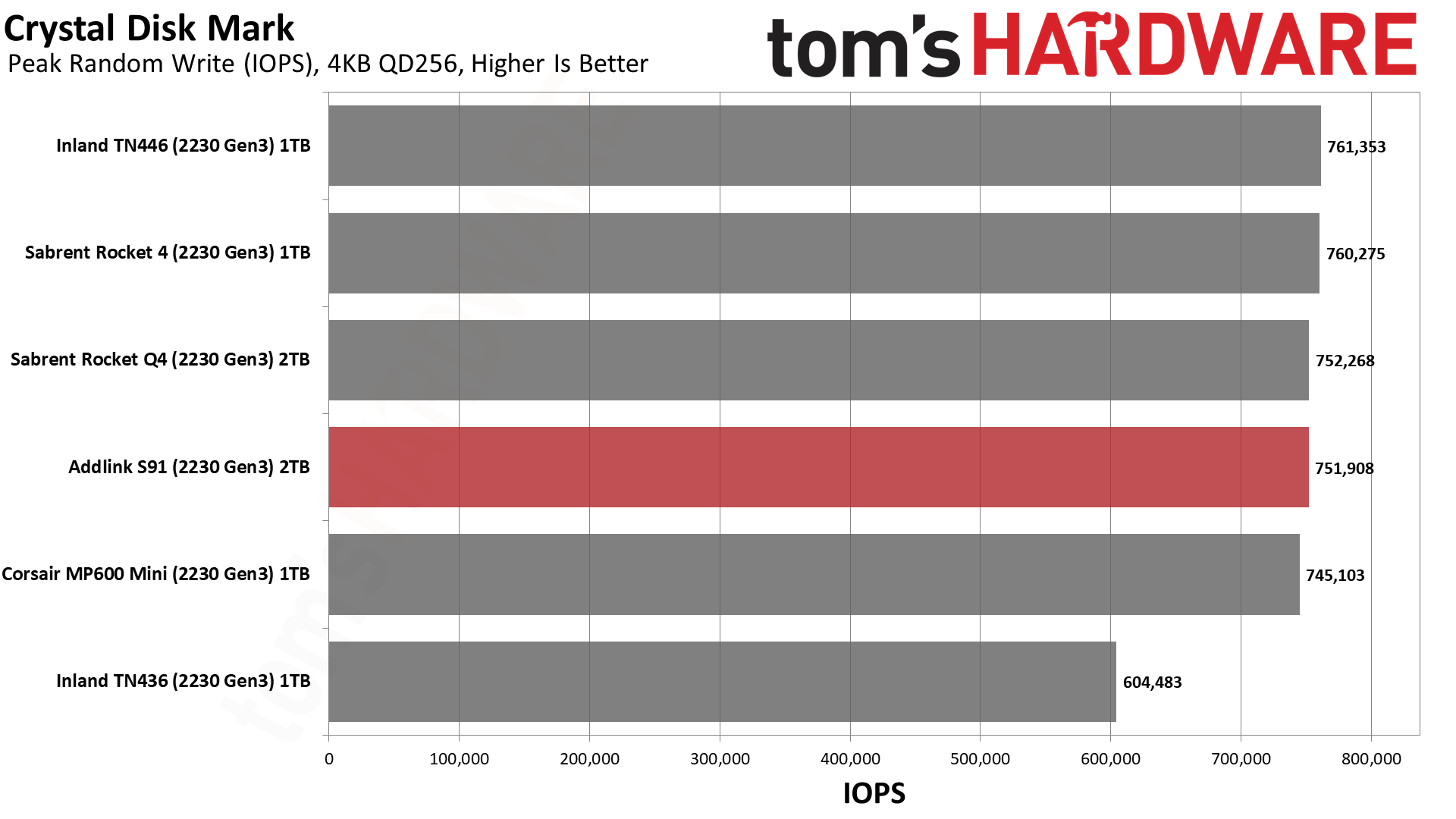
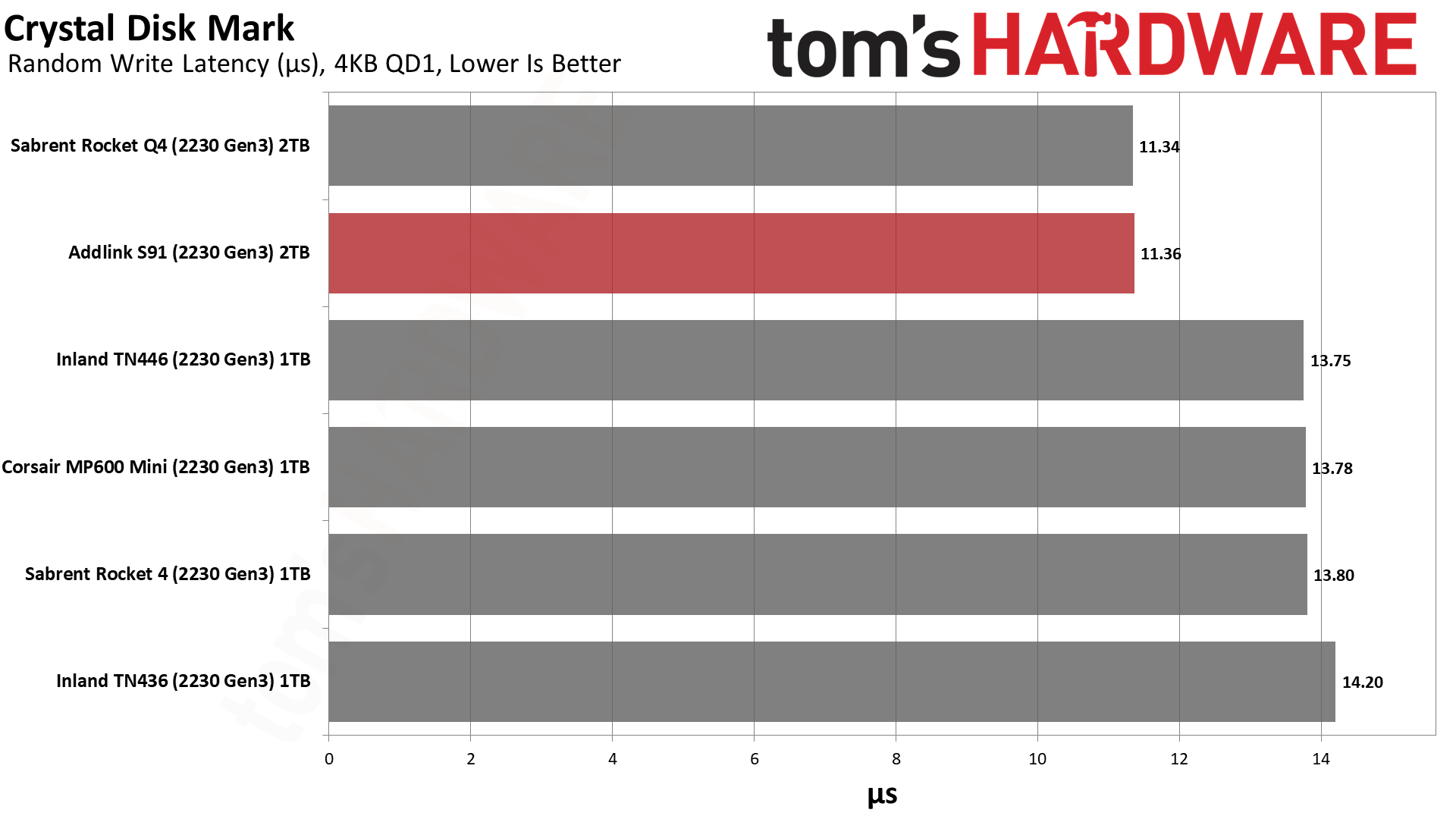
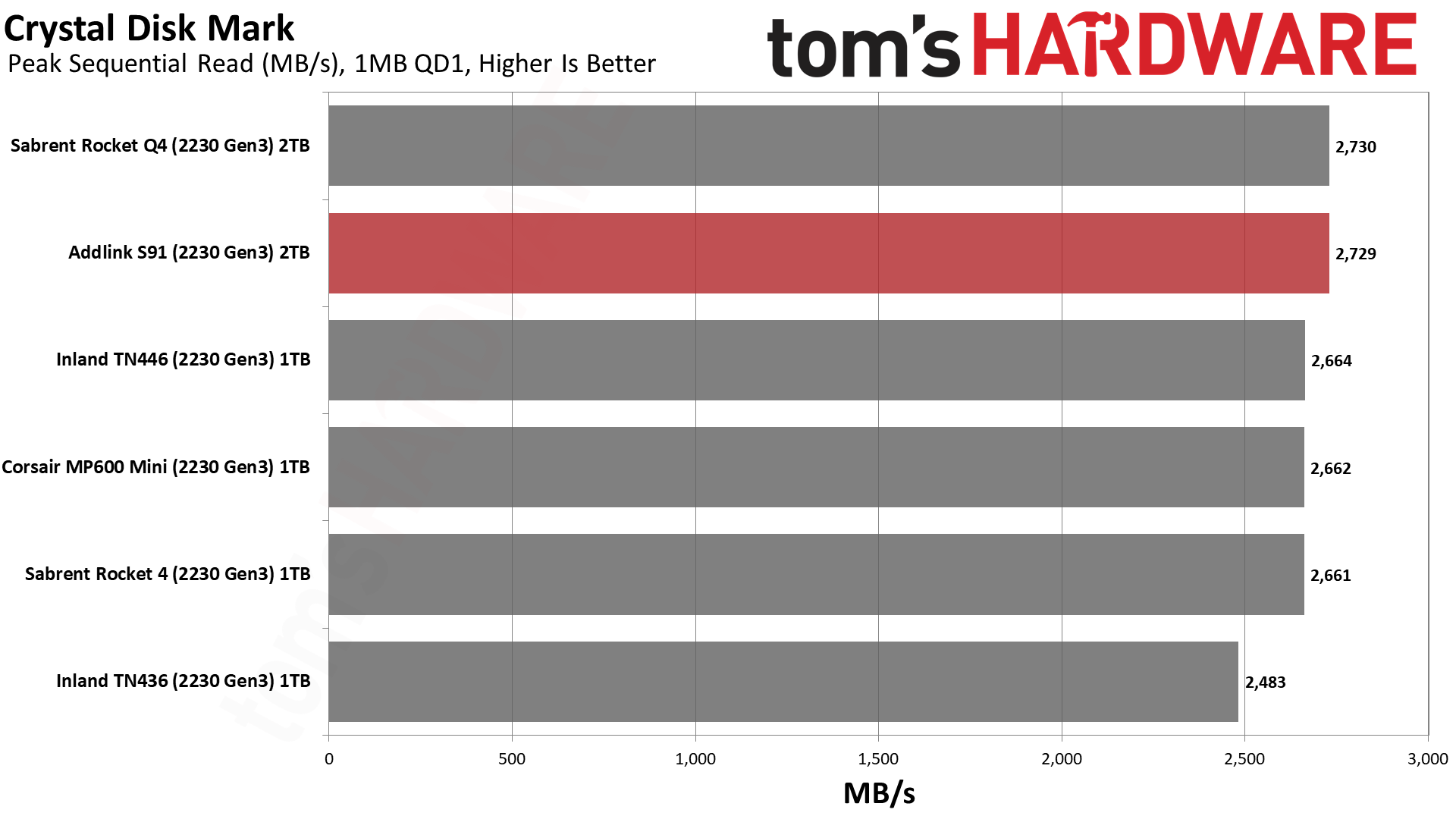
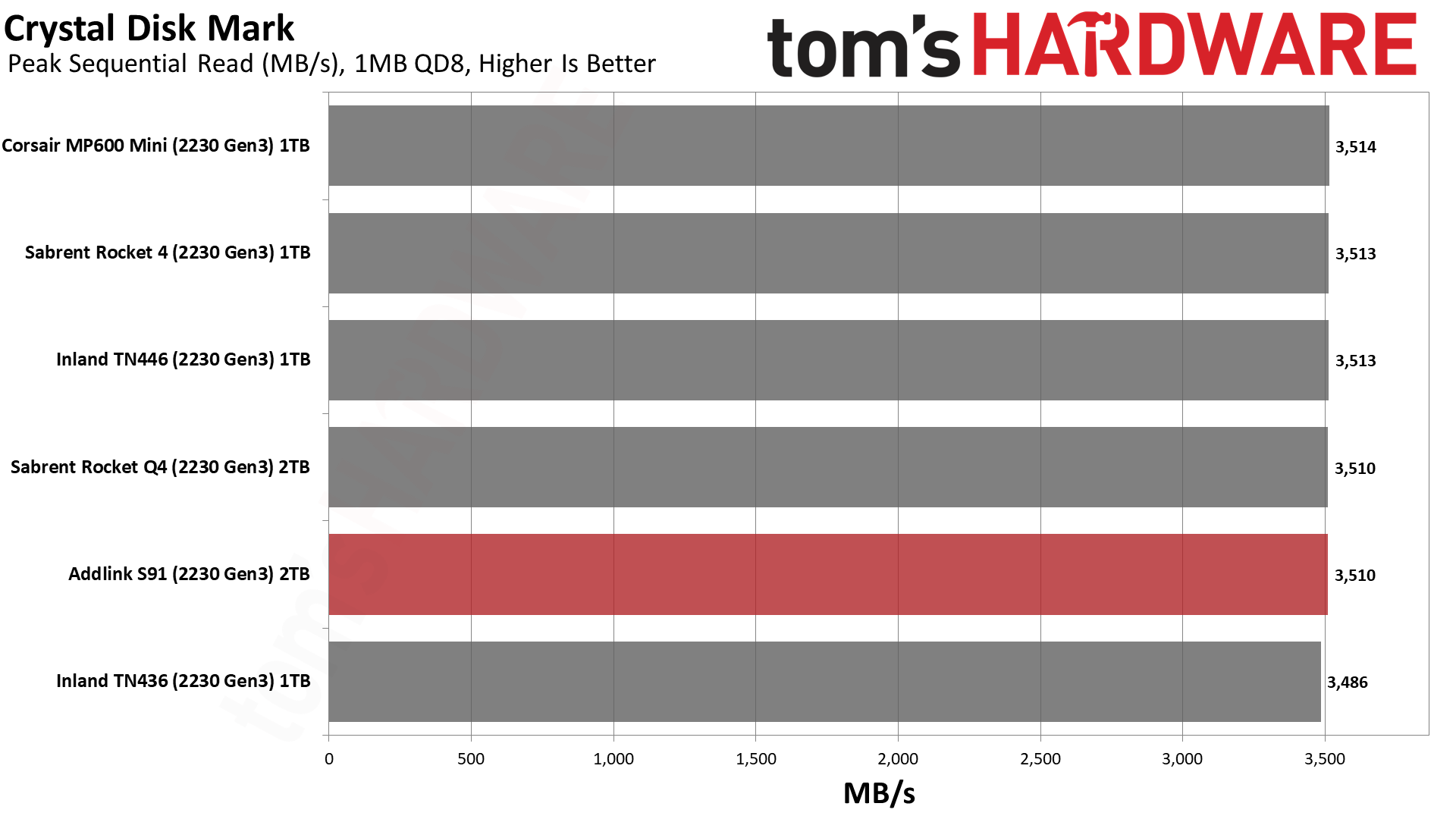
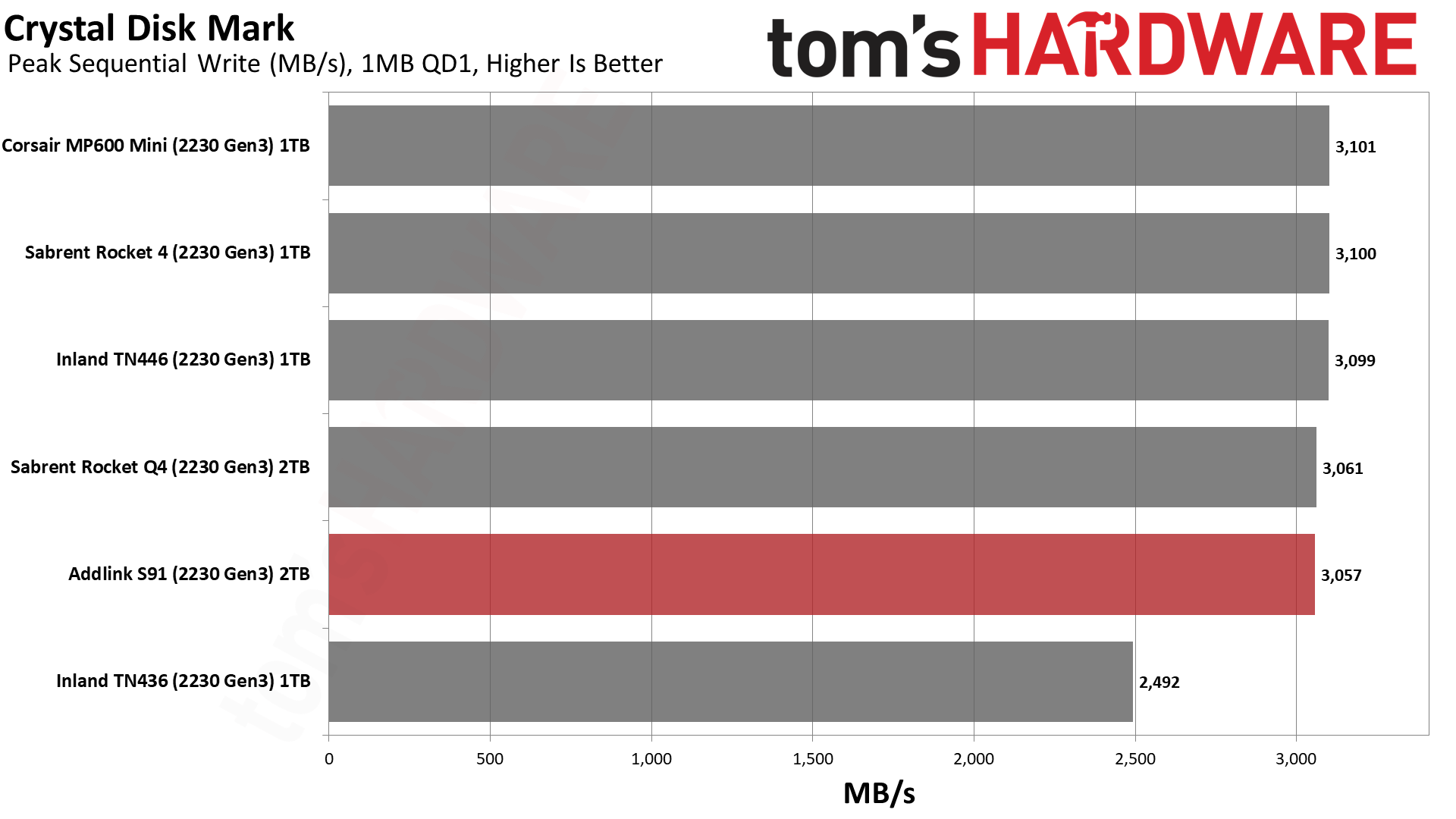

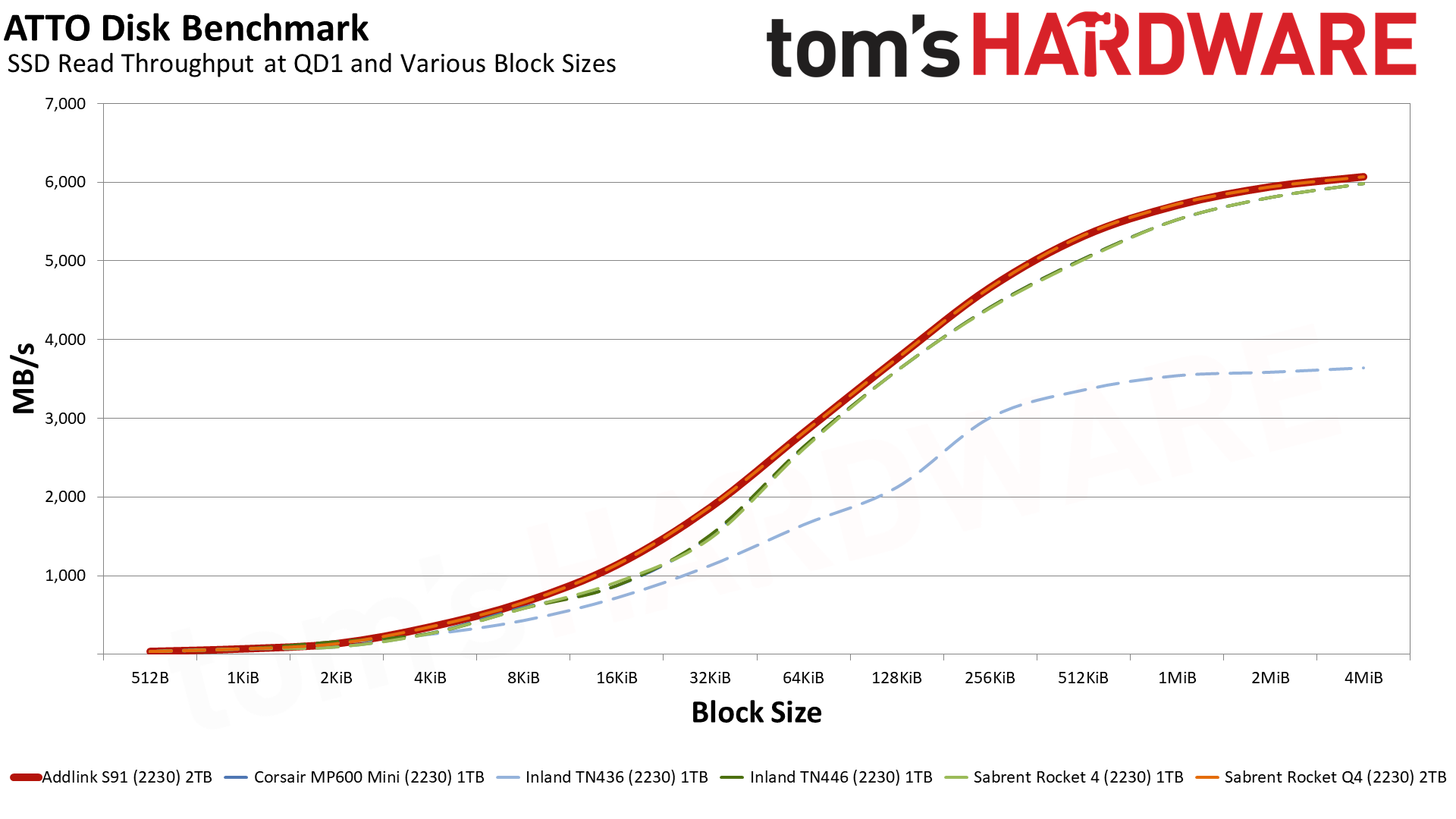

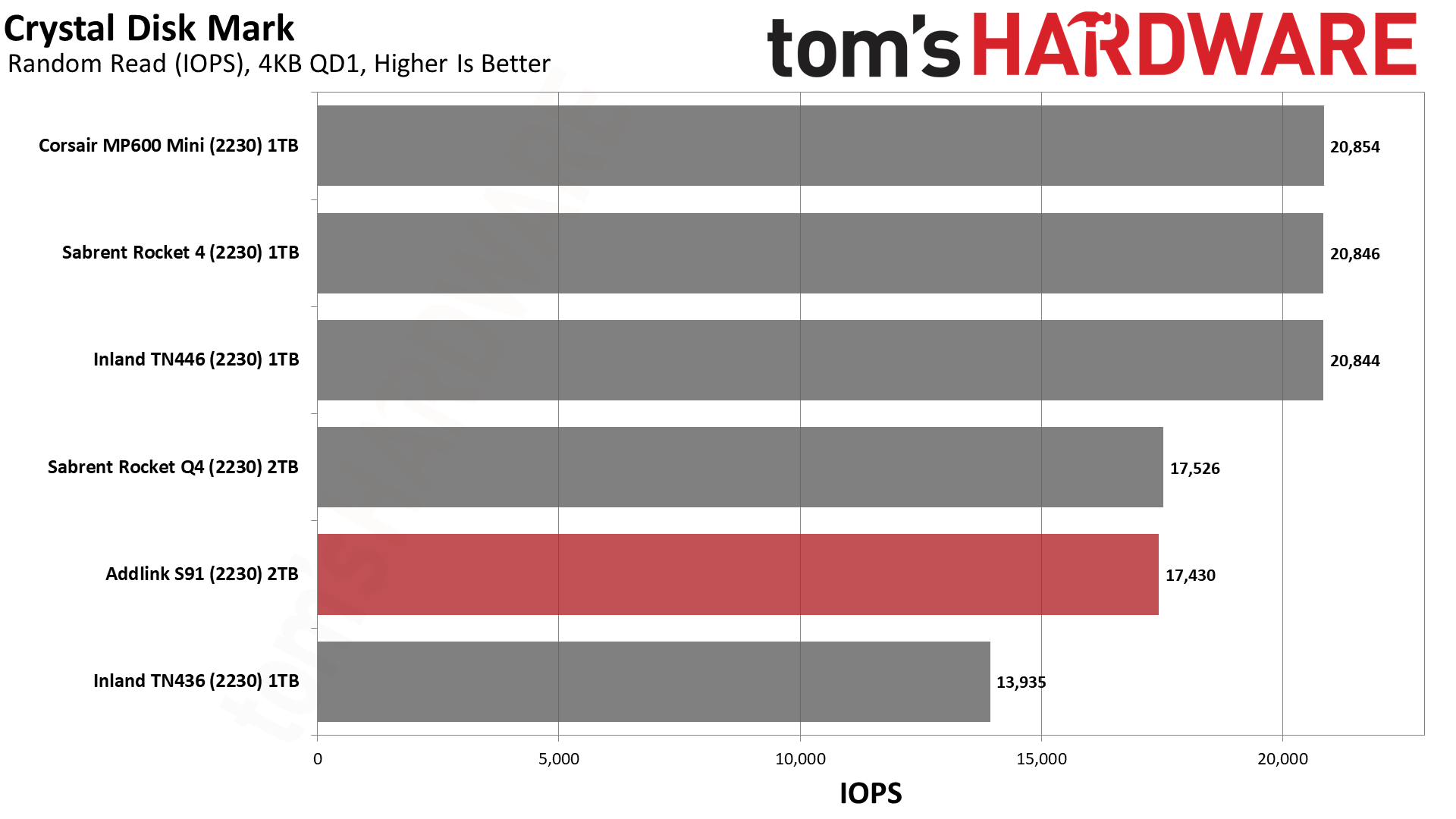
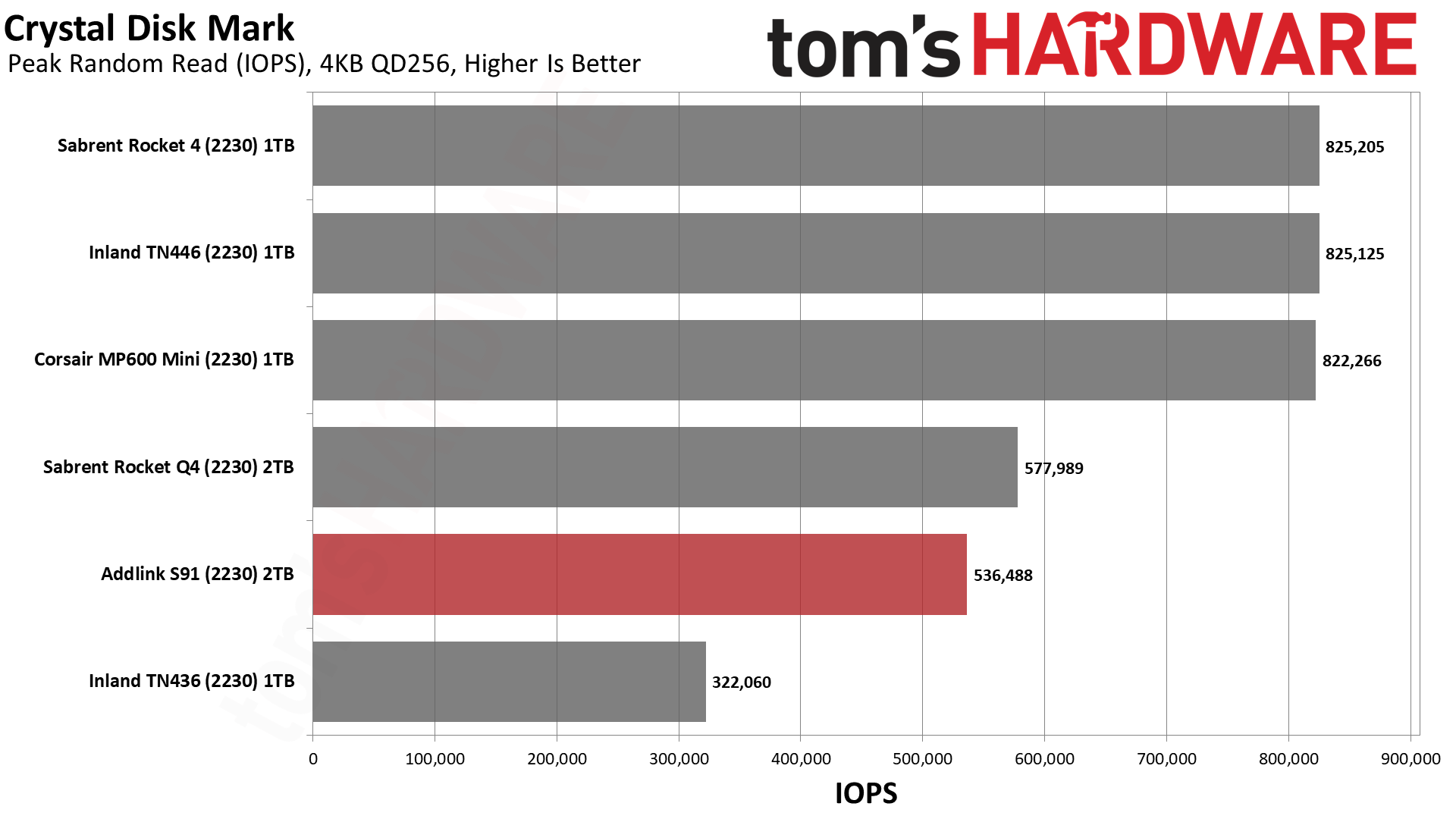
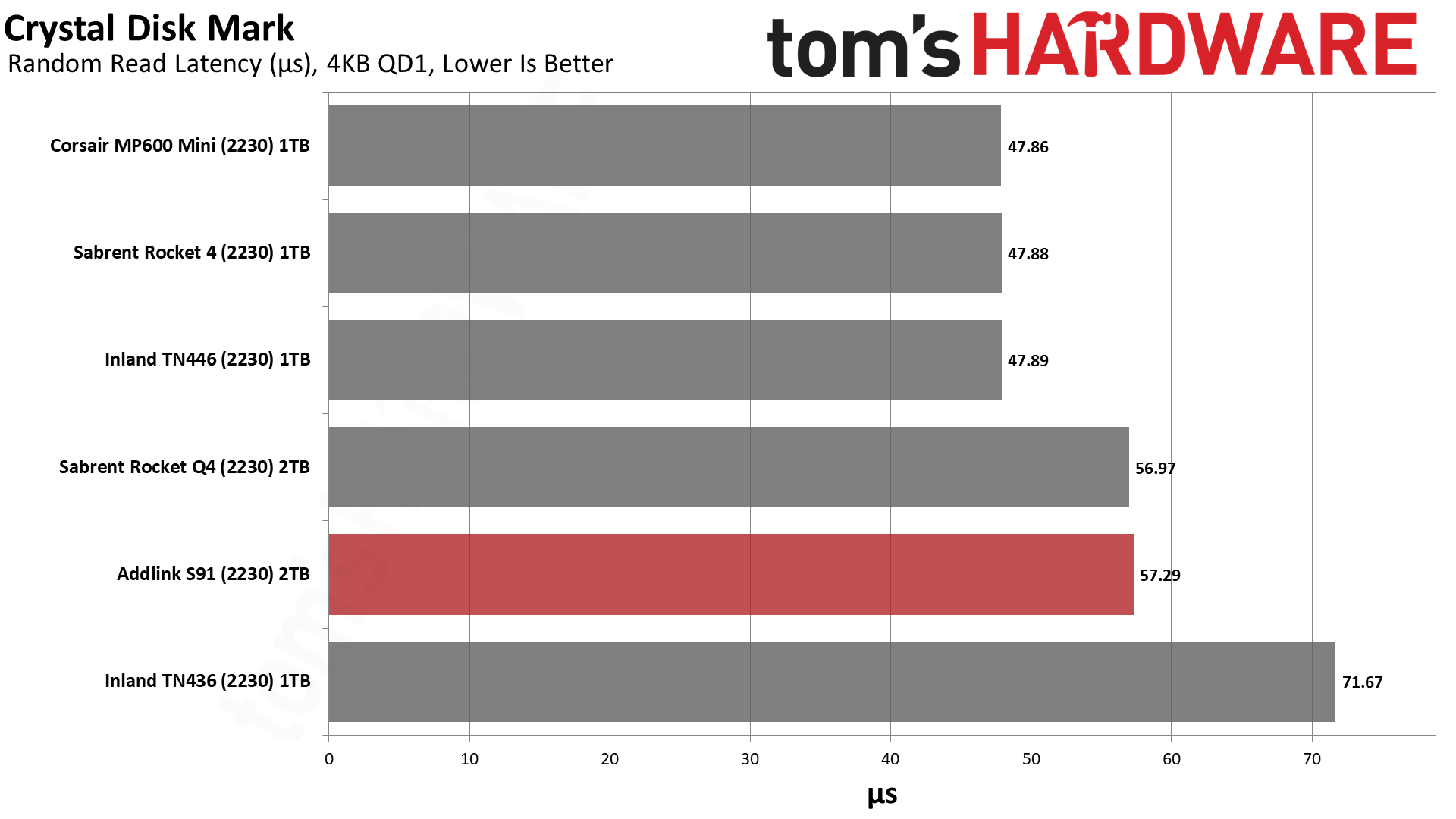
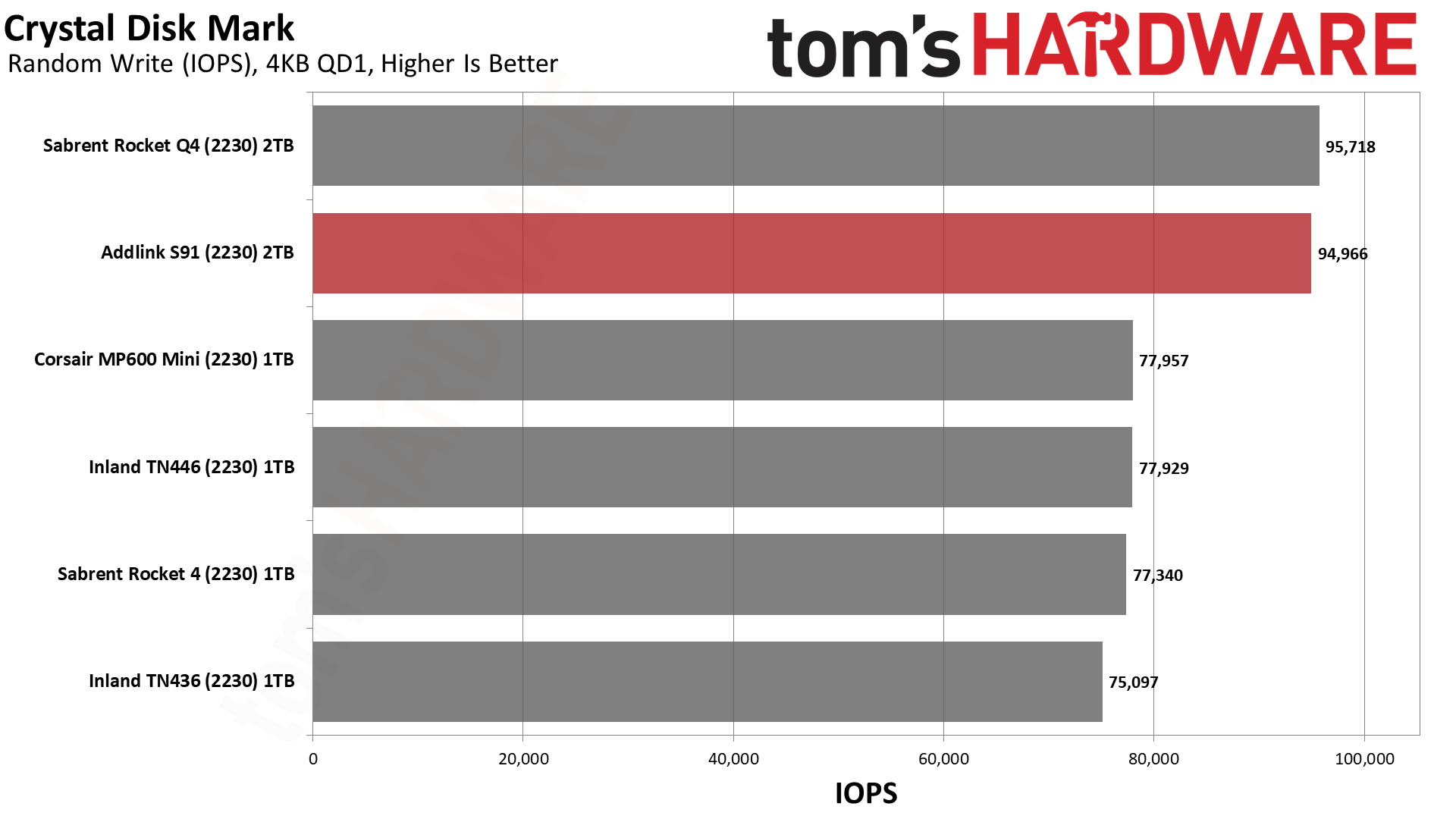
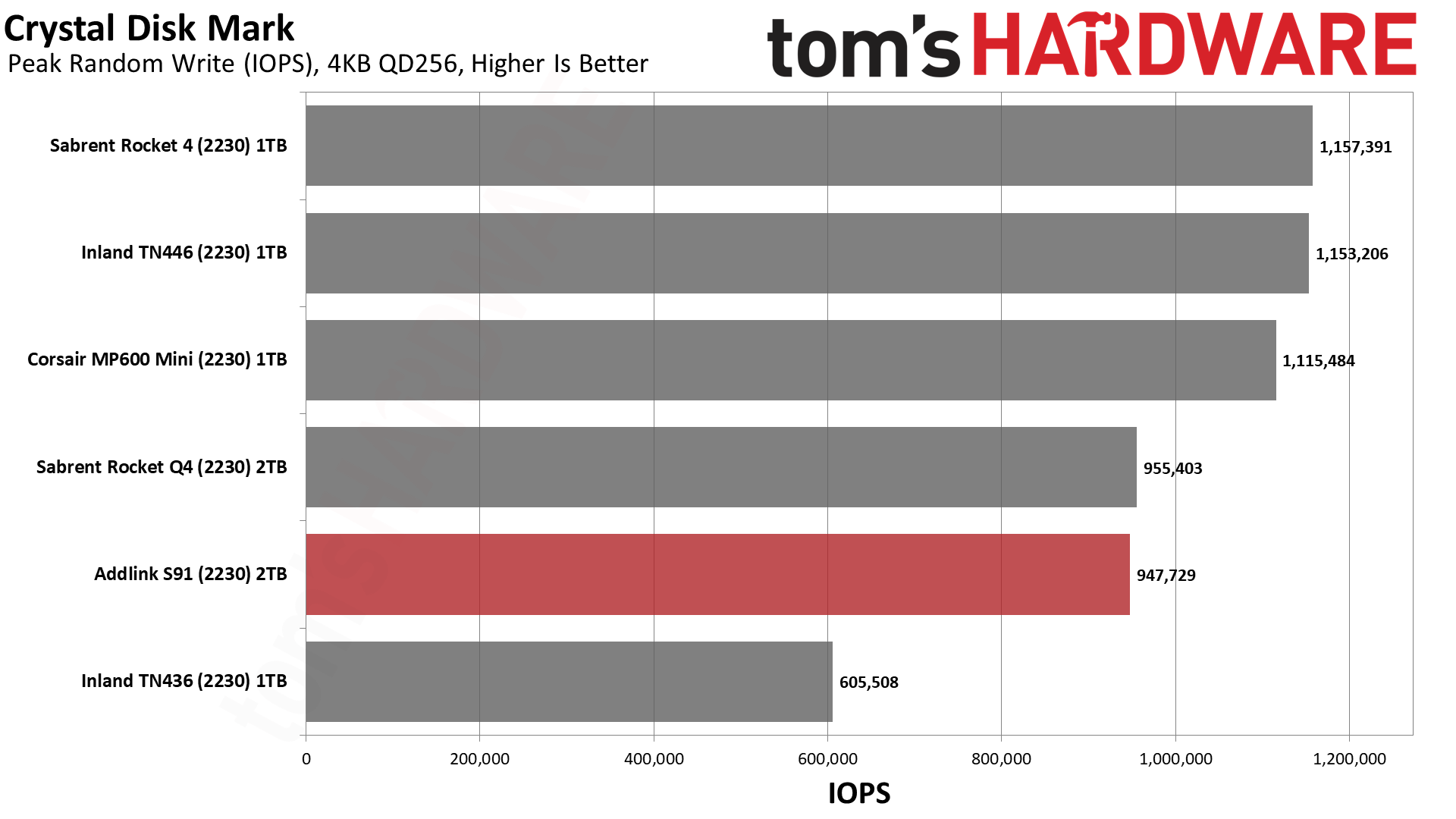

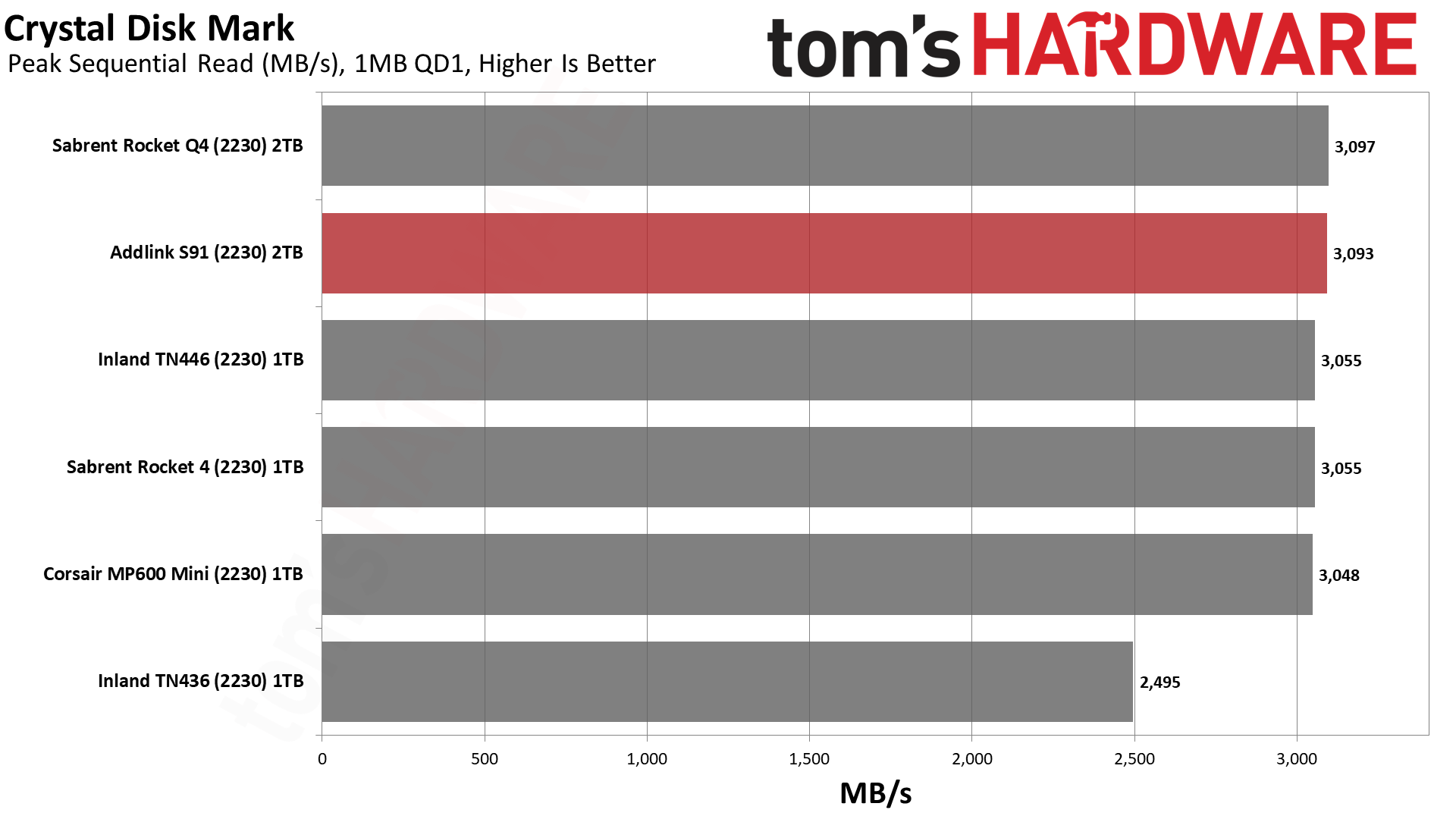


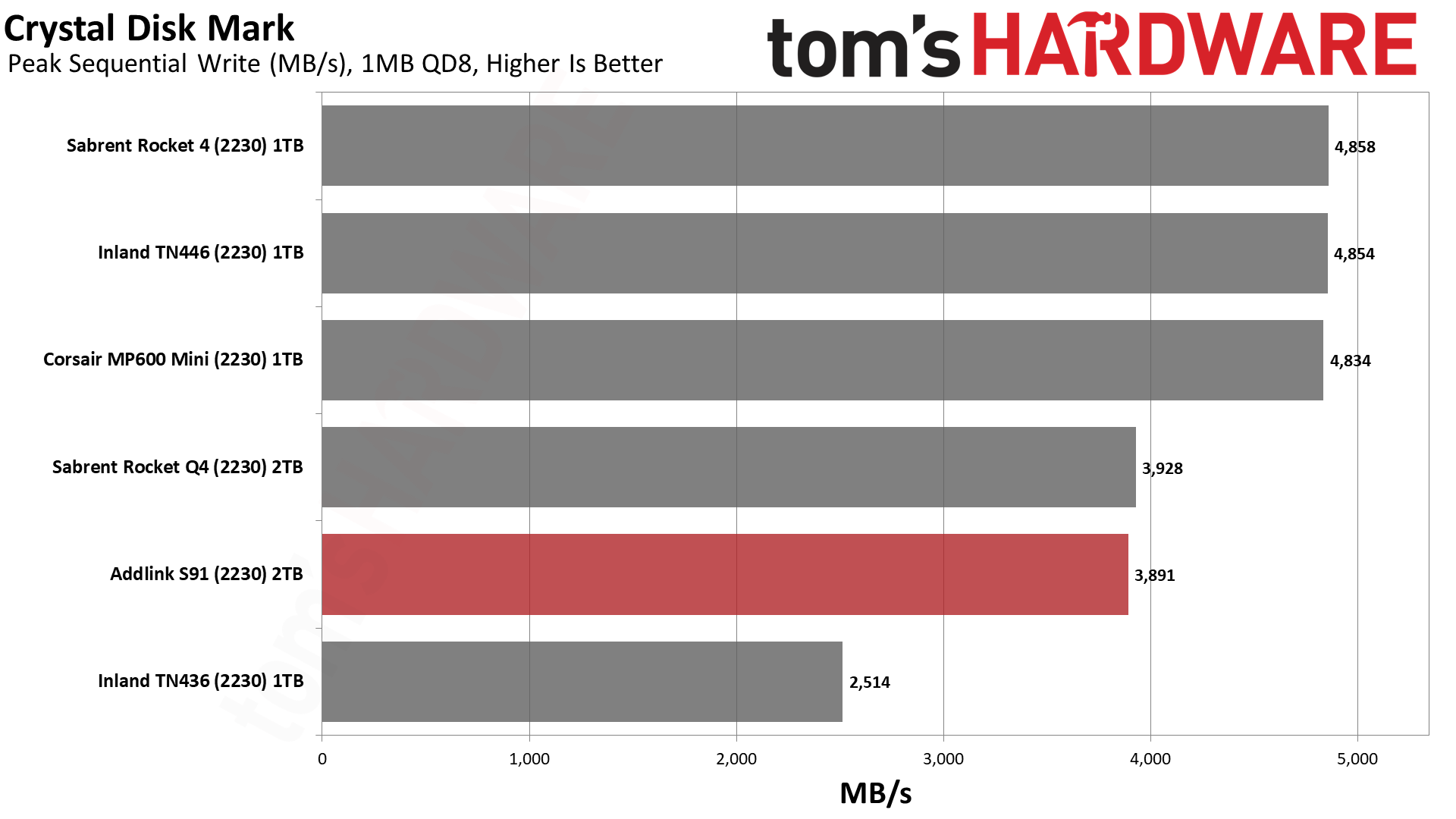
The S91 does well in ATTO, as expected from its Phison E21T controller. Sequential performance in CrystalDiskMark is good, too, aside from sequential writes in PCIe 4.0 mode. That’s where the TLC drives can pull away. Future DRAM-less 4.0 designs will be faster than this, though.
Random 4KB read latency is high, but 4KB write latency is low on the S91. This is characteristic of its QLC flash. The 512GB S91 will have significantly better read latency thanks to it using BiCS5 TLC flash. 4KB latency does improve in PCIe 4.0 mode, but only by a small amount. This does mean that a TLC drive will get you the best real-world performance, but the difference may be difficult to tell.
PC Sustained Write Performance and Cache Recovery
Official write specifications are only part of the performance picture. Most SSDs implement a write cache, which is a fast area of (usually) pseudo-SLC programmed flash that absorbs incoming data. Sustained write speeds can suffer tremendously once the workload spills outside of the cache and into the "native" TLC or QLC flash.
We use Iometer to hammer the SSD with sequential writes for 15 minutes to measure both the size of the write cache and performance after the cache is saturated. We also monitor cache recovery via multiple idle rounds.
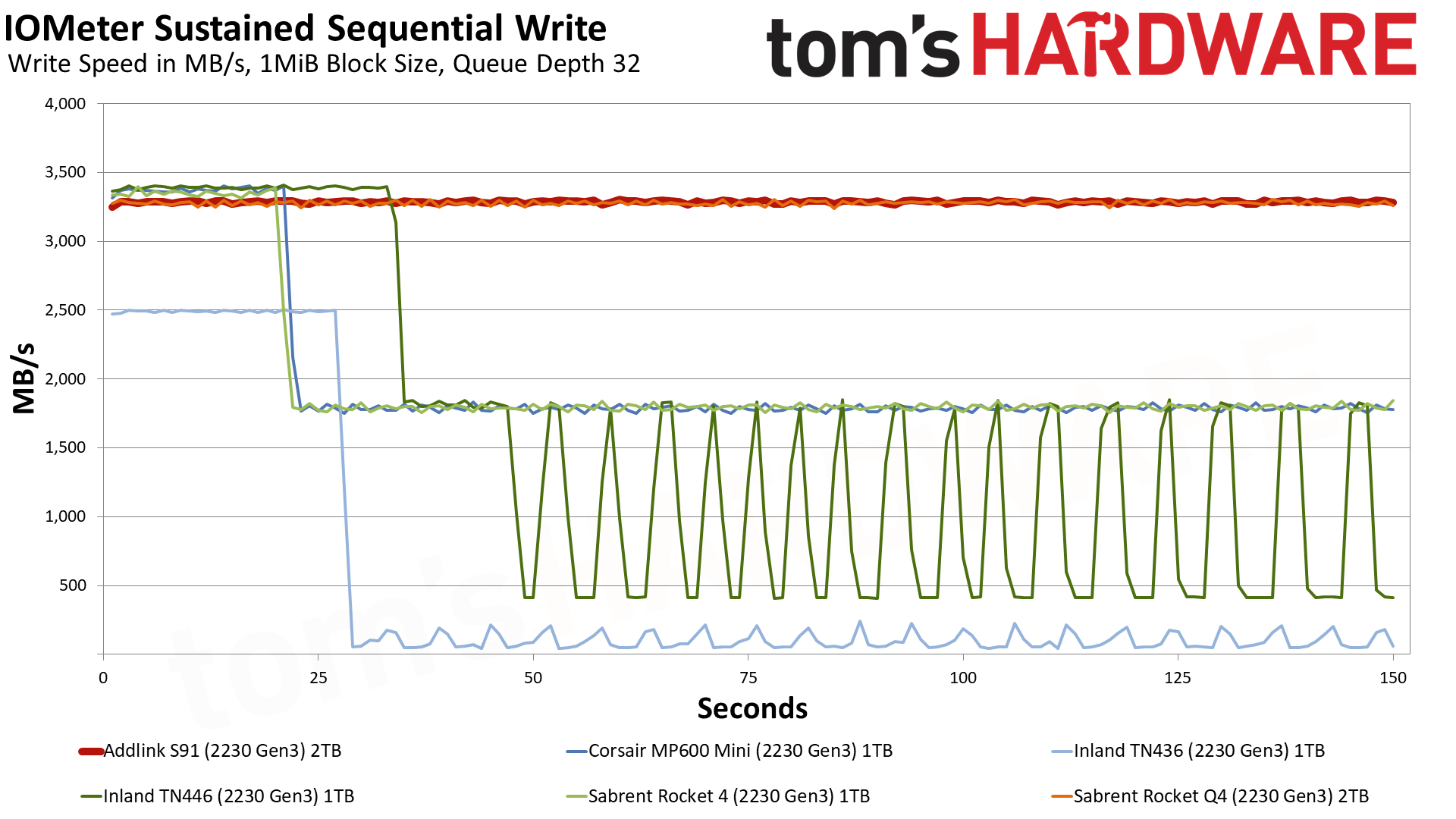
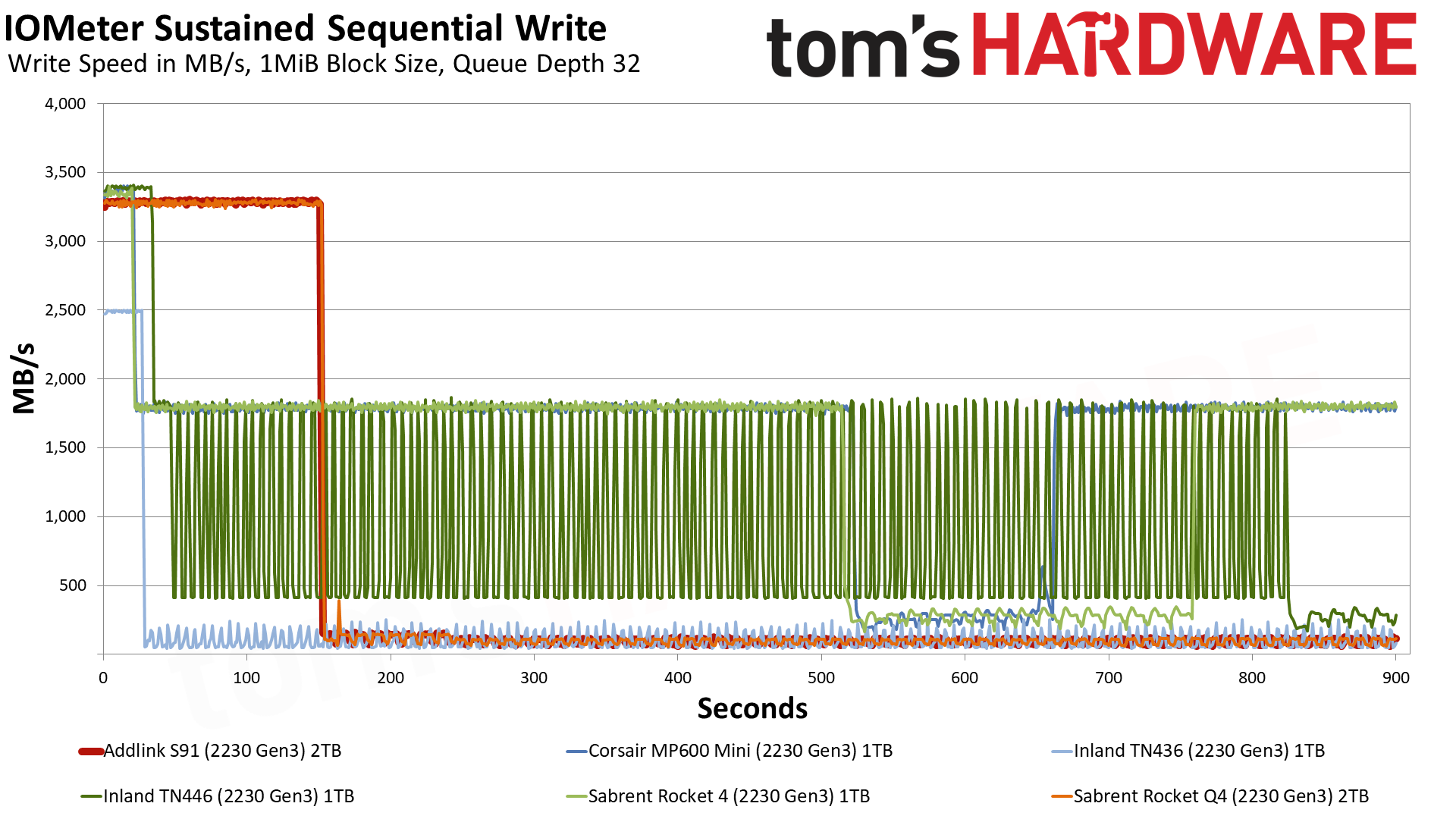



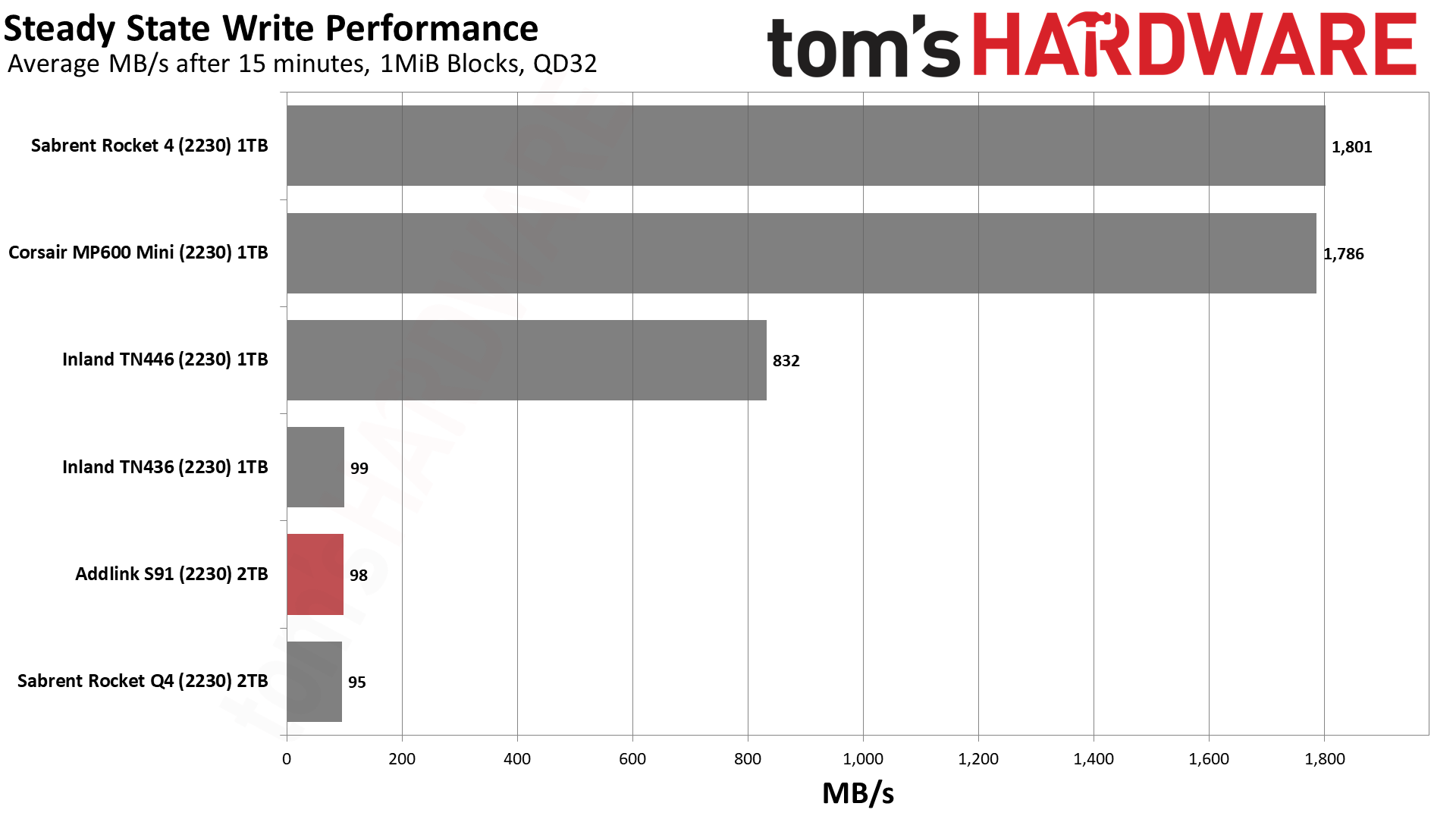
Unsurprisingly, the S91 has a massive pSLC cache like the Rocket Q4 2230 — approximately a quarter of the available user space. After depleting this cache, the drive plummets to 100 MB/s or less. This state may be seen after initial installation if you’re doing a lot of writes, but the drive will recover when given sufficient idle time. Going with a TLC drive is a viable option, but not at 2TB, aside from the SN740, which would have better steady state performance.
Power Consumption
We use the Quarch HD Programmable Power Module to gain a deeper understanding of power characteristics. Idle power consumption is an important aspect to consider, especially if you're looking for a laptop upgrade as even the best ultrabooks can have mediocre storage.
Some SSDs can consume watts of power at idle while better-suited ones sip just milliwatts. Average workload power consumption and max consumption are two other aspects of power consumption, but performance-per-watt is more important. A drive might consume more power during any given workload, but accomplishing a task faster allows the drive to drop into an idle state more quickly, ultimately saving energy.
For temperature recording we currently poll the drive’s primary composite sensor during testing with a 24C ambient.
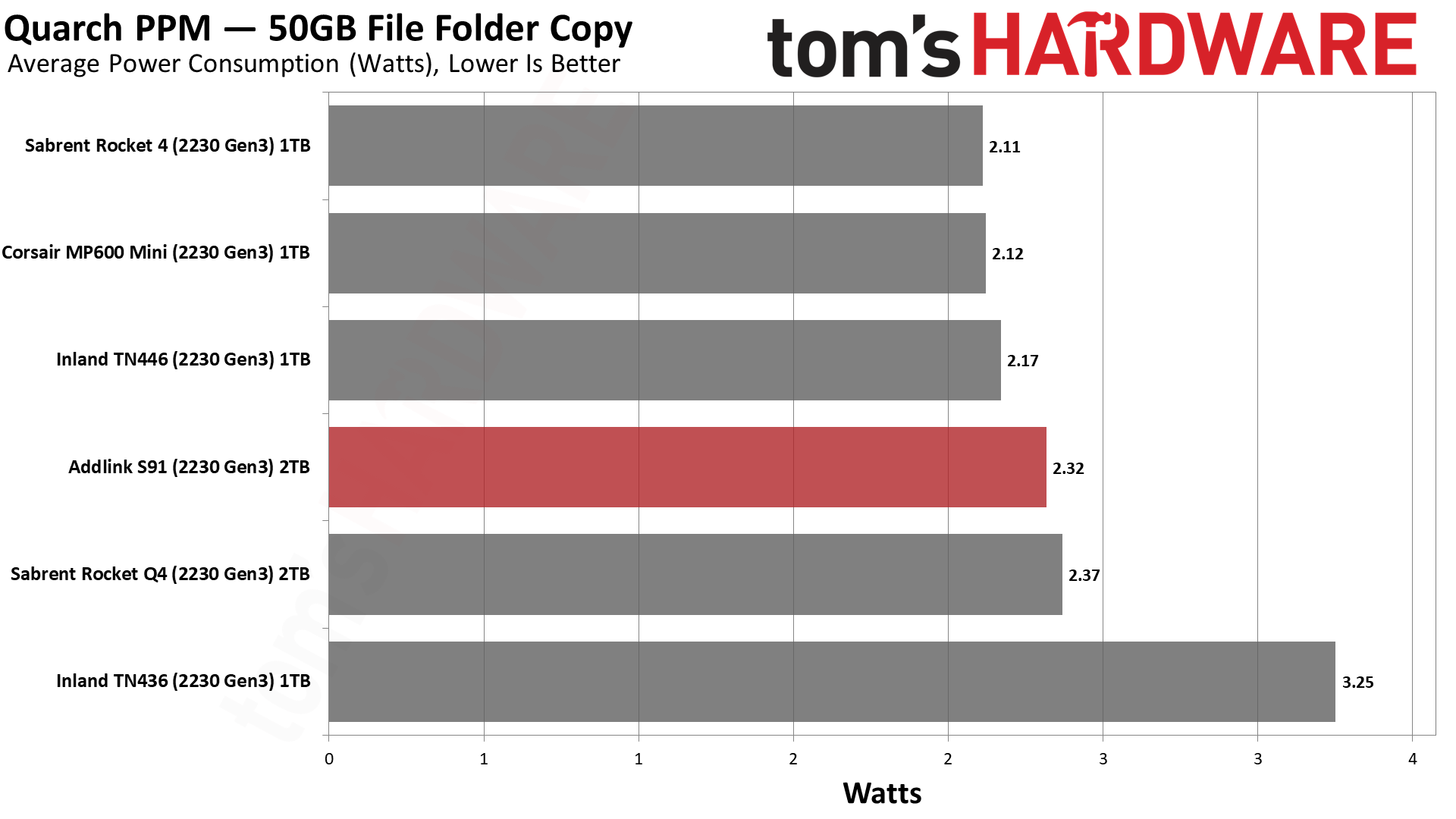
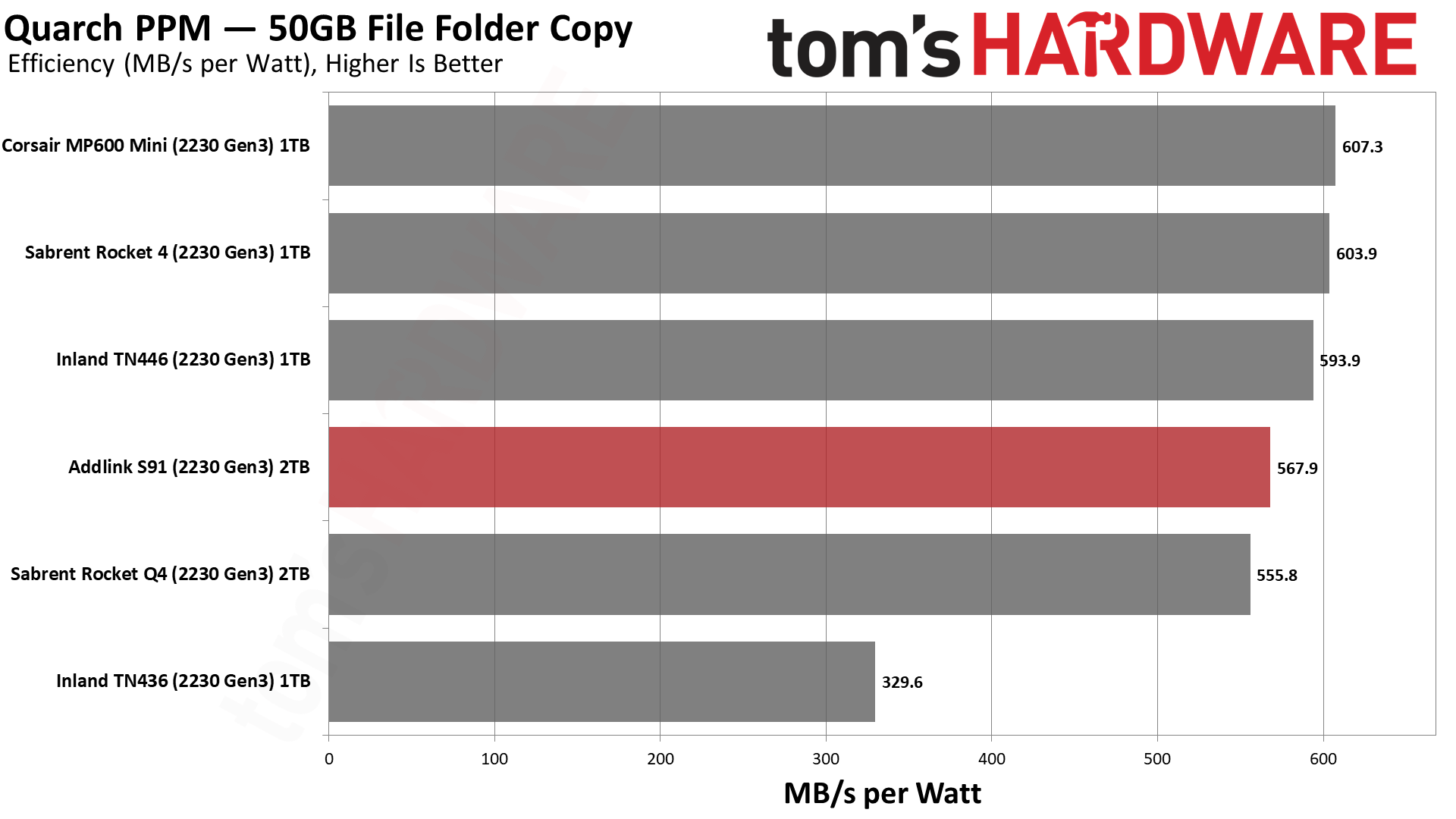

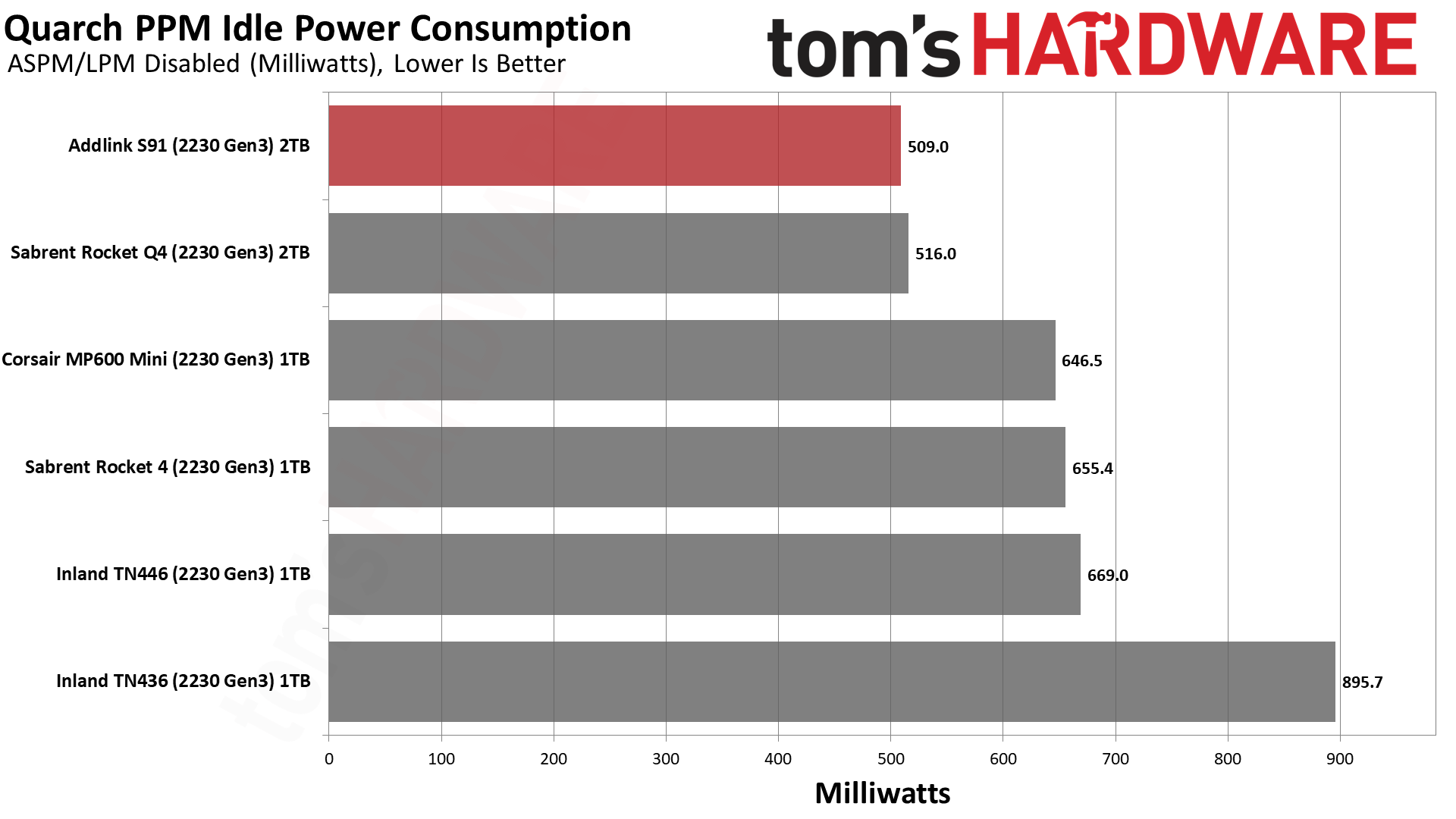
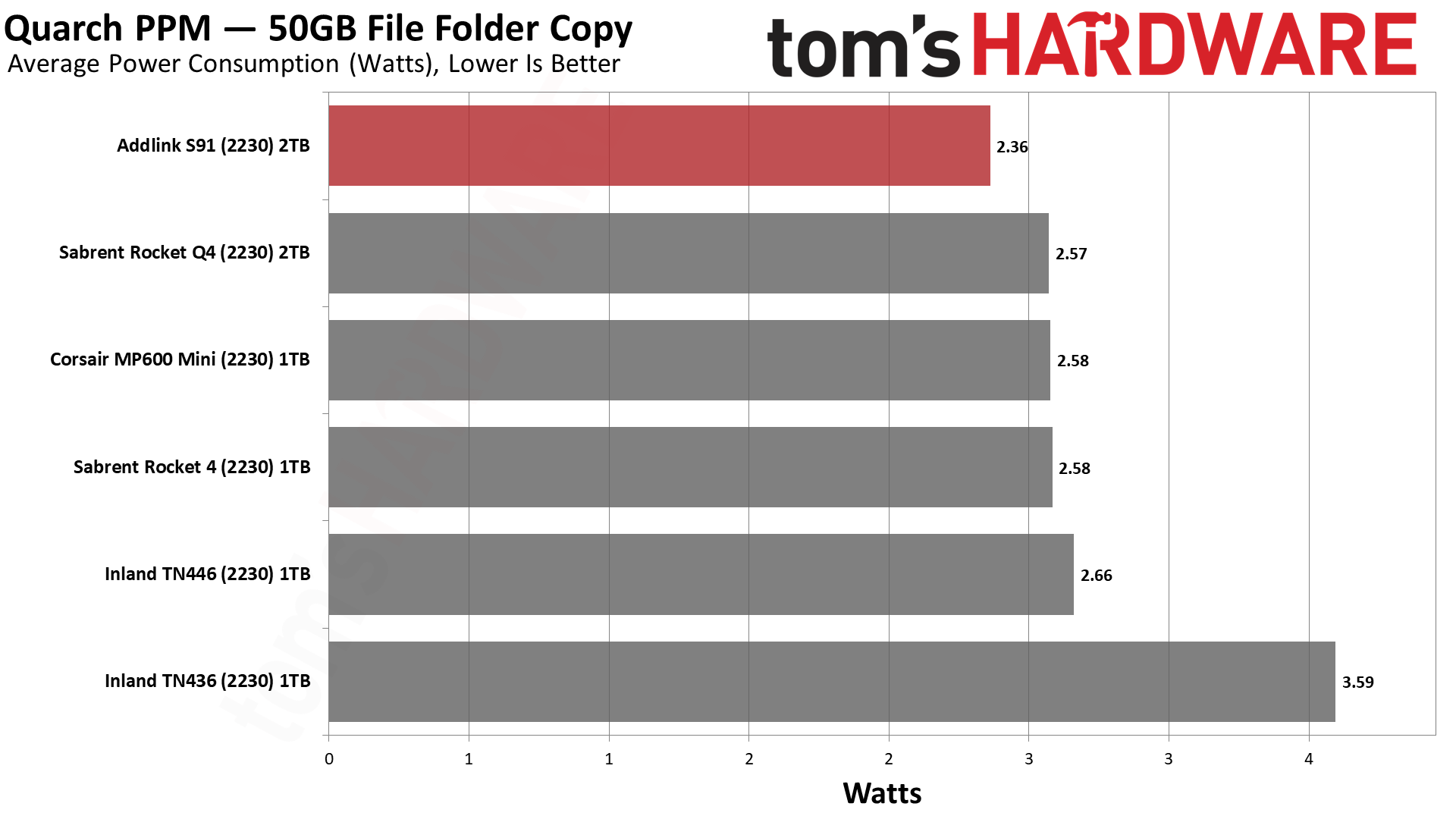
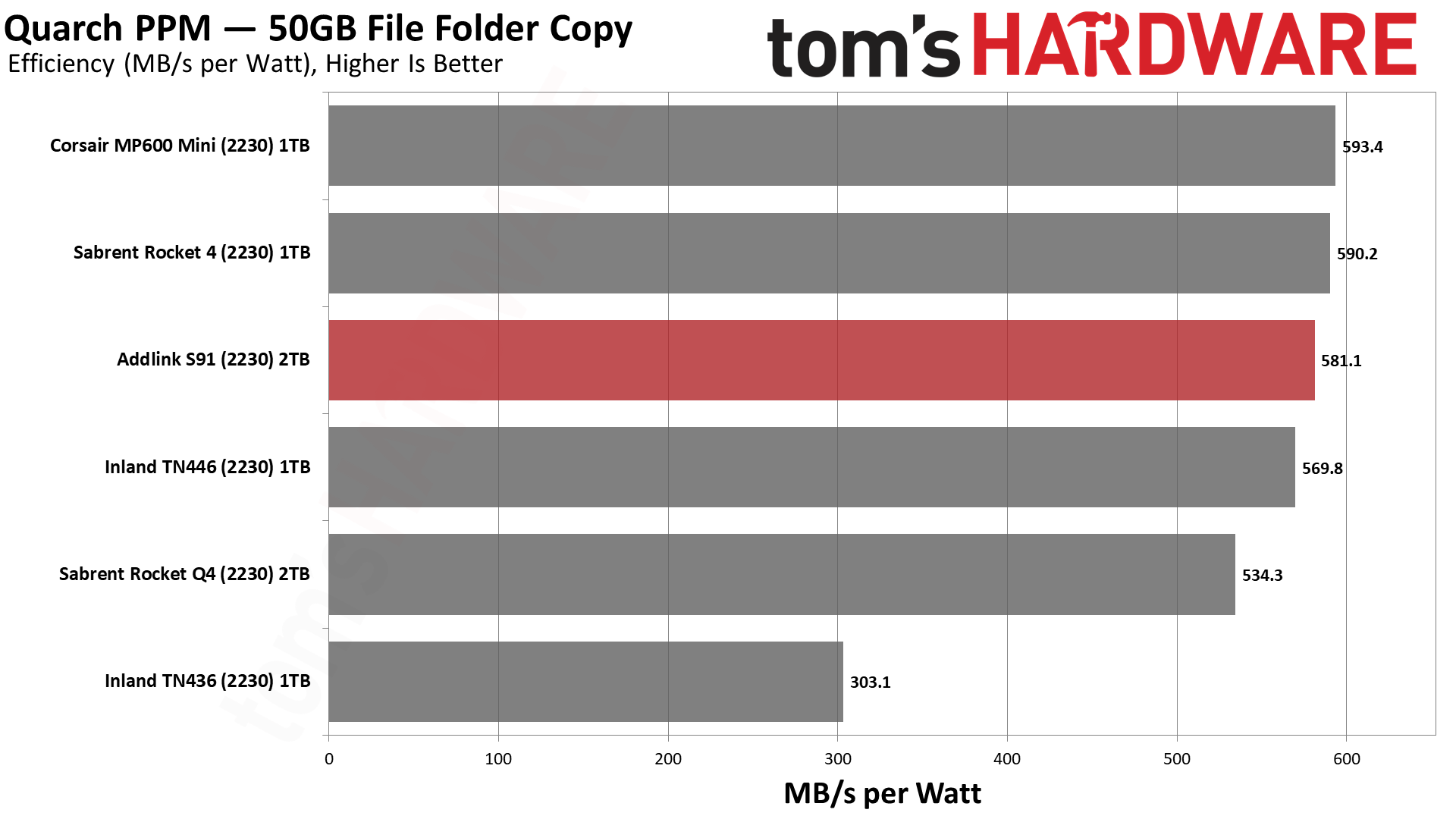
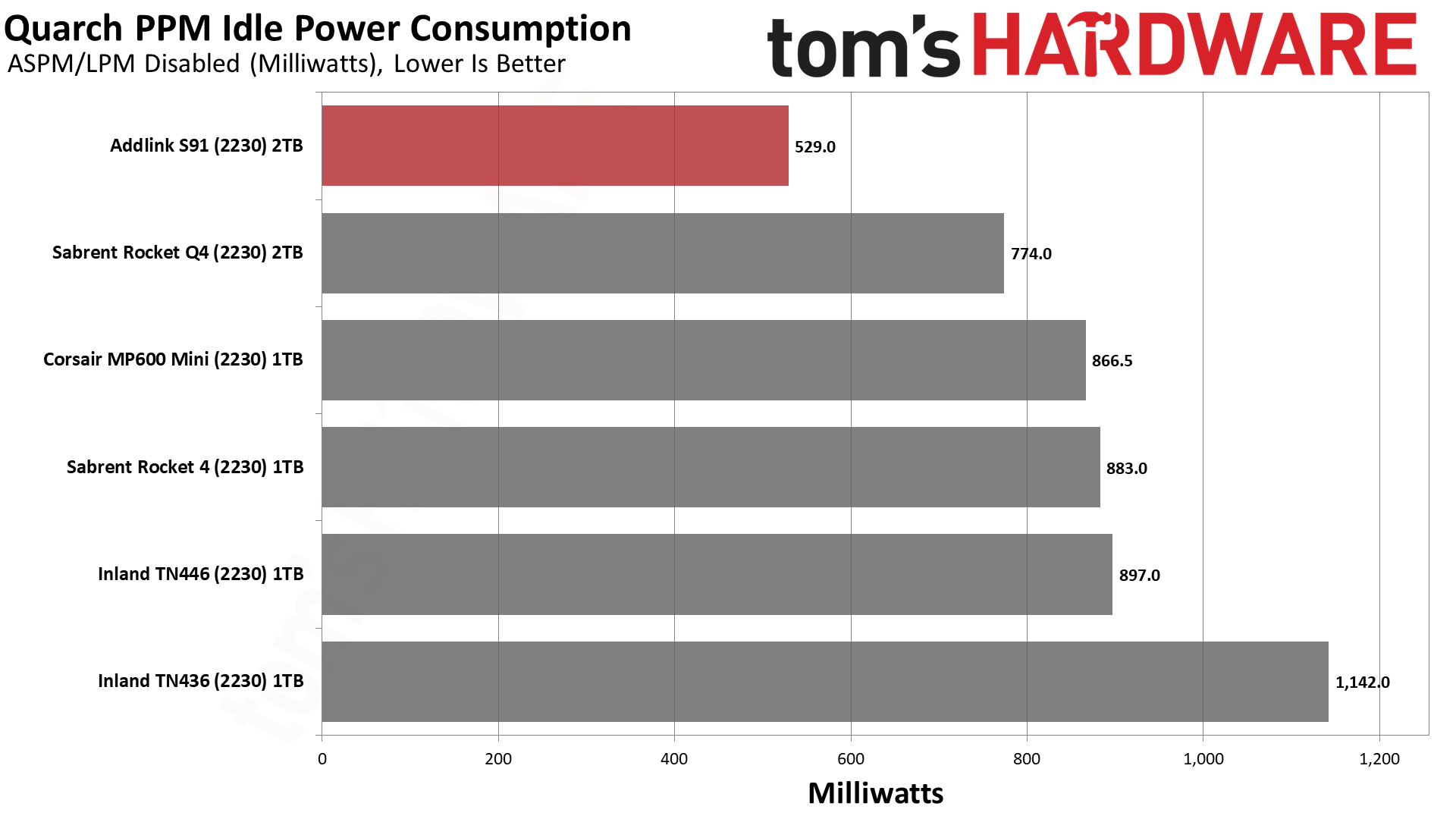

The S91 has good power efficiency in both PCIe 3.0 and 4.0 modes. Usually, these drives will be more efficient in the former for real-world usage, but certain workloads can benefit from PCIe 4.0 bandwidth.
In either case, the S91 is far more efficient than the older TN436 and drives like it, and all of the newer drives - TLC or QLC - will be more efficient in our testing than the SN740, based on SN770 results. The Micron 2400 is still a mystery, but we’d expect it to be somewhat less efficient due to its use of the SMI SM2269XT controller. (This is based on our results with the P41 Plus and the ADATA Legend 960, which suggest SMI’s dual-core, ARM Cortex-R8 architecture is less efficient than the Phison E21T.)
The actual difference in device battery life will likely be small in most cases, although it’s worth avoiding older technology.
The S91 runs at similar temperatures to the Rocket Q4 2230, which did not throttle but reached 79C in our testing. The shorter form factor can lead to higher temperatures, particularly in crowded devices like the Steam Deck. There may be limited options to cool this drive, but in practice, any throttling should not be a huge deal in terms of performance. The Deck runs at PCIe 3.0, which helps a little, too.
Test Bench and Testing Notes
| CPU | Intel Core i9-12900K |
| Motherboard | Asus ROG Maximus Z790 Hero |
| Memory | 2x16GB G.Skill DDR5-5600 CL28 |
| Graphics | Intel Iris Xe UHD Graphics 770 |
| CPU Cooling | Enermax Aquafusion 240 |
| Case | Cooler Master TD500 Mesh V2 |
| Power Supply | Cooler Master V850 i Gold |
| OS Storage | Sabrent Rocket 4 Plus 2TB |
| Operating System | Windows 11 Pro |
We use an Alder Lake platform with most background applications such as indexing, Windows updates, and anti-virus disabled in the OS to reduce run-to-run variability. Each SSD is prefilled to 50% capacity and tested as a secondary device. Unless noted, we use active cooling for all SSDs.
Conclusion
The Addlink S91 reminds us a lot of the Sabrent Rocket Q4 2230, which is not surprising; the drives use the same hardware. Currently, the 2TB S91 is a little bit less expensive, but the Rocket Q4 2230 may have the edge with better support.
The S91 also has 512GB and 1TB options, with the former using TLC flash instead of QLC. We think the Inland TN436 is the best bet at 512GB, unless you can find a Rocket 2230 on sale. At 1TB, the market is much more crowded, but the S91 offers a way to save a few bucks over the TLC options, although performance will be lower.
Performance is also a concern when it comes to QLC flash, but we feel it’s an acceptable compromise at 2TB, especially for use in an embedded or portable system like Valve’s Steam Deck, ASUS’s ROG Ally, or Microsoft’s Surface Pro. You don’t need desktop PC levels of performance, and the overall system is usually not able to fully make use of faster storage. That said, QLC drives with large caches can bog down in certain cases, particularly if the drive is very full. Right now, the best way around that is to get the WD SN740, but that drive is more expensive and power-hungry.
A third option is on the way with the Team MP44S, which we will be reviewing. It should perform on par with the S91 and Rocket Q4 2230, but we’ll have to see. Any of these three options are a good choice for 2TB and of more limited attraction for 1TB.
It’s good to have efficient options beyond what was available with the TN436, BG5 clones, and older drives, including stock drives that had older technology. The Addlink S91's capacity is an added bonus and worthwhile over relying on microSD cards or external storage, but be aware that it has strong contenders with excellent pricing that you'll need to consider before you checkout.
MORE: Best SSDs
MORE: Best External SSDs and Hard Drives
MORE: How We Test HDDs And SSDs
MORE: All SSD Content

Shane Downing is a Freelance Reviewer for Tom’s Hardware US, covering consumer storage hardware.
-
Yeshwant Kethineni Hi, will we see a NM790 (ideally 4TB) review soon?Reply
TPU's efficiency numbers look decent for the price -
DaveLTX The key thing to remember is that any sort of writing QLC is just far less efficient. Even if working from cache, the controller has to spend time moving from pSLC to QLC, which takes considerably longer than TLCReply
Dramless TLCs then are the most efficient without any performance hit
A older controller combined with QLC is worst possible combination of course
Hoping to see 2230 TLC based on maxio controllers -
Yeshwant Kethineni Reply
there are DRAM drives that are competitive efficiency-wise though, but yeah thanks I never thought of thatDaveLTX said:The key thing to remember is that any sort of writing QLC is just far less efficient. Even if working from cache, the controller has to spend time moving from pSLC to QLC, which takes considerably longer than TLC
Dramless TLCs then are the most efficient without any performance hit
A older controller combined with QLC is worst possible combination of course
Hoping to see 2230 TLC based on maxio controllers
